

2025 PASTEL SOCIETY OF THE WEST COAST
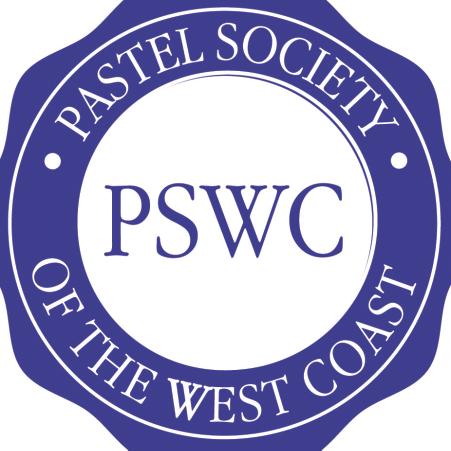



39th ANNUAL INTERNATIONAL OPEN EXHIBITION


Hilbert Museum of California Art at Chapman University, Orange, California
August 23 –November 29, 2025
Awards Reception ∑
September 6, 2025
5:30 – 8:00 pm



2025 PASTEL SOCIETY OF THE WEST COAST




39th ANNUAL INTERNATIONAL OPEN EXHIBITION


Hilbert Museum of California Art at Chapman University, Orange, California
August 23 –November 29, 2025
Awards Reception ∑
September 6, 2025
5:30 – 8:00 pm


SUPPLEMENT 2025 Pastels USA: 99 Voices in Pastel Accepted Entries Featured Artist Andrew McDermott Meet the Members
Kim Essex
Trish Findlater
SA Kushinka
Judy Miller
Lydia Steves
Colette Odya Smith
Doug Dawson
Anne Strutz
Laura Pollak
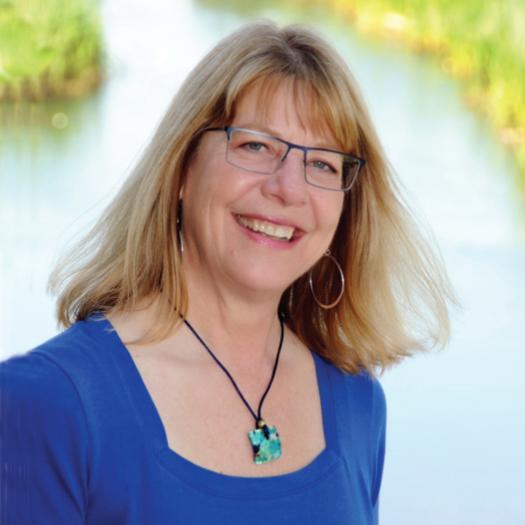

Dear Artists,
With this international issue, we feature artists who make their home, whether full time or part time, in countries other than the United States. Our featured artist, Andrew McDermott hails from our northern neighbor, Canada. In this global and interconnected world, it has never been easier to paint and play wherever your heart desires. No matter how geographically isolated as an artist you may be, there is always an online connection to foster dialogue and camaraderie with other artists.
Art as an international communicator is not merely a cliché. Art invites us to explore the vast condition of human experience, reflecting our joys, struggles, and aspirations. Viewing a piece of art, we engage in a dialogue with the artist and with ourselves. This dialogue unfolds around the colors, the textures of materials, and the forms that dance before our eyes. Art does not require translation and its significance can be felt deeply by anyone willing to engage with it. A simple pastel stroke can tell tales of love, loss, and hope, bridging the gaps between generations and geographies.
In these pages, we hope you’ll experience a strong response as you view the art for our Pastels USA: 99 Voices in Pastel exhibition. Ninety-nine paintings were picked from the more than 400 works submitted. Our accomplished jurors, Marla Baggetta, Michael Freeman, and Sandra Burshell chose the paintings for the show and our esteemed judge, Colette Odya Smith will determine the outstanding paintings to receive awards. Unfortunately, the awards will not have been presented in time for this magazine to go to press but look for the award winners in our next issue. If you are in the area, we invite you to attend the awards reception at the Hilbert Museum of California Art at Chapman University in Orange, California, on September 6, 2025 from 5:30–8:00 pm.
I’d like to give a heartfelt thanks to all the sponsors who support Pastel Society of the West Coast and the artists in the Pastels USA: 99 Voices exhibition. Many of these sponsors step up, year after year, with generous product or cash donations. Next time you order or have a conversation with one of our sponsors, please thank them for their support. You’ll find the list of sponsors on page 64.
Wishing you many happy days of painting!
“To be an artist is to believe in life.”
—Henry Moore
Francesca


Pam Comfort, PSWC President
In addition to serving as President, Pam chairs the Scholarship Program and the Ways and Means position. She earned a doctorate in Educational Leadership and retired after a long career in public education. Pam loves to travel and aspires to create art that communicates a strong sense of nature, culture, and place. pamelacomfort.com


Kim Essex grew up in the Chicago-land area and raised her family in Denver. She has a journalism degree from Drake University in Des Moines, Iowa. Kim is two years into her pastel journey, having started painting after retiring from a career in public relations and moving to Valencia, Spain, with her husband Sean and dog Trax. She says she hopes she has artistic genes; her mother, aunt, brother, niece and grandfather were all artists. She is a student of Marla Baggetta and is taking drawing classes in Valencia along with attending workshops. She believes everyone should surround themselves with original art as it reminds us of our shared humanity and the beauty within.


Christine Bowman is a member of the Pastel Society of America and the Red Rock Pastel Society. She has received numerous awards for her work, is also a photographer, teaches sketchbook classes, and enjoys local plein air painting near her home in Southern California and the San Pasqual Valley. Christine also volunteers as a member of the International Association of Pastel Societies (IAPS) Communication Committee. christinebowman.com


Sharon Faer Lichtenstein was originally from New York but is now a Florida-based artist working primarily in soft pastel. Her recent work centers on the native Gulf Coast landscape. Frequent travels abroad also inspire her work, as she aims to convey mood and atmosphere through the interplay of color, texture, and light.

WANT TO GET INVOLVED?
Our Society runs on volunteer power. We’re always grateful to receive more help.
Please contact us— we have a spot for you!
KEEP IN TOUCH FOLLOW US!




Fine Art Connoisseur serves art collectors and enthusiasts with innovative articles about representational paintings, sculptures, drawings, and prints—both historical and contemporary, American and European. A proud sponsor of the Pastel Society of the West Coast
Dear Fellow Pastelists,
A year ago, my letter to you described my very first foray into plein air painting at a workshop in Florence, Italy with Marla Baggetta. Here we are 12 months later, and the back cover of this issue is “graced” with a photo of me painting at Lake Tahoe while attending the 12th Annual Plein Air Convention. It was another first for me. Although I certainly enjoyed the demonstrations, the art show, the Expo, and the plein air excursions—the best part of all was seeing and visiting with so many artist friends who were in attendance! There was even a bit of a “mini-reunion” moment with Marla and a couple of other attendees from last year’s Italian workshop. Once again, I left the event having made new connections, and feeling a sense of belonging that comes from being embraced by an art community that wraps you in a warm, vibrant tapestry of creativity and support. This is the magic of being in a place where your unique voice is not only welcomed but celebrated, where you can share your ideas and receive constructive feedback without feeling judged. It is a place created not by any venue, or any sponsor, but by the participants— the artists and artist instructors themselves. It is a beautiful thing.
I feel fortunate to belong to such a community. I also have come to believe that for most of us, it is a necessity in order to thrive because the path to success can be filled with self-doubt and rejection. Our featured artist, Andrew McDermott knew at an early age that the key to his success would be to stay relentlessly focused on his primary goal. Joining a high profile art society opened up connections and opportunities, and he made sure he was prepared to make the most of those opportunities. Read my conversation with Andrew and find out why he rejects the idea of having a Plan B.
This issue features our 39th Annual International PASTELS USA: 99 Voices in Pastel Exhibition showing from August 23–November 29 at the Hilbert Museum of California Art in Orange, California. The awards will


not yet have been selected by our judge, Colette Odya Smith by the time of printing, but will be announced at the reception on September 6. Awarded works will be included in the Winter issue of the PSWC magazine. Although images of the accepted works are included in this issue, there is no substitute for seeing the exhibition in person. So, if at all possible, I highly recommend that you strive to visit the Hilbert before the show closes. The museum reopened in early 2024 after a $12 million expansion that tripled it in size to more than 22,000 square feet, adding a second building and a café, community room, research library and outdoor areas. It’s a prestigious venue for a beautiful show.
Also in this issue, our Meet the Members section and Art School article have a travel and international flavored theme. The highlighted members are all either international, expat or part-time residents and the Art School section features ideas about keeping a travel sketchbook. For both of these features, I was able to rally the assistance of some friends in our beautiful art community and they came through with flying colors. Everything you read about in this magazine reflects a tapestry of creativity and support. Everything our society is able to accomplish is due to the efforts of a community of volunteers supporting on another. Every. Single. Thing.
You are cordially invited to join the effort.
Pam




Bonnie Zahn Griffith chats with well-known artists in an informal virtual setting. A Zoom presentation for members of the PSWC.
With every chat I have with the invited artists I get more excited to bring this Zoom presentation to our membership. We Talk Art sessions are recorded and available on the PSWC YouTube channel for you to reference. So many of the artists I have visited with have shared a wealth of knowledge during our sessions. Access them at your convenience to learn about their nuggets of wisdom. You can find the list of archived interviews on the We Talk Art page of the PSWC website: pswc.ws/we-talk-art-2/
On July 19, I talked with Jen Evenhus, a skilled and personable artist from Washington state. Her website tag line “The beauty of Imperfection” really says it all about Jen’s work. She shared so many great words of wisdom and delightful stories. If you missed it, it is recorded and available on the PSWC YouTube channel








Our Sunday, September 21st We Talk Art will be with guest artist Eve Miller. I am looking forward to our visit and hearing her story. A little bit about Eve:
Traveling throughout Europe while growing up influenced her love of landscapes. From the fertile valleys in Western Europe to the arid texture of the Middle East, Eve always studied the variety of the landscape and especially the changing cloud formations. For Eve the sky is the most emotional element of the landscape, and it is the focus of her studies. These visions have become part of her current artwork. Eve moved to Beaufort, South Carolina in 2003. The Low Country’s beauty found in the surrounding coastline and marshes were to be the inspiration for what has become her visual poetry.






Our Saturday, November 15 talk will round off the year with a visit with Sandra Burshell the accomplished artist and founder of the New Orleans Drawing Group, an online Zoom live, weekly figure drawing session. if you want to work on your figure drawing skills this is a great Zoom opportunity to engage in! I am looking forward to our chat and to hearing Sandra’s story!


If you have someone you’d like to see interviewed on We Talk Art, please reach out to me. My email is bzgriff53@gmail.com
Enjoy the rest of your summer painting and be sure to frequently log onto the PSWC website at pswc.ws for information on workshops, scheduled events, shows and so much more!
Congratulations to all who have had work accepted in the Pastels USA: 99 Voices 2025 exhibition at the Hilbert Museum!
This past May, Clark Mitchell, our regional representative for the Sebastopol, Napa and Sonoma area hosted a three-day outdoor workshop on his country property and at a nearby regional park. Everyone learned a great deal, including Clark! It was one of the many well-organized spring events sponsored by PSWC.
Clark will be hosting a paint-out at Tolay Lake Park, from 9:30 to 12:30 on Thursday, September 18, 2025. The address is at 5869 Cannon Lane, outside Petaluma, California. There are a great variety of scenes to paint, including everything from farm buildings, to grand eucalyptus stands, to marshlands and views of nearby hills.
There is a park fee of $8 or free with a Sonoma County Regional Parks pass. Bathrooms are available. Bring plenty of water, lunch for yourself or something to share.
Please let Clark know if you plan to attend: 706.477.0276
Date & Time:Thursday, September 18, 2025 9:30 am to 12:30 pm
Location: Tolay Lake Park 5869 Cannon Lane Petaluma, California
Contact: Clark Mitchell: 706.477.0276




Painter and California Native, Kim Lordier received her Bachelor of Fine Arts degree from the Academy of Art University, San Francisco and University of San Francisco. Flight attendant, competitive horsewoman, and artist, her career path varied until the events of September 2001, when she committed to her life’s work as an artist. Kim will represent the San Francisco Bay Area Peninsula to Big Sur region.
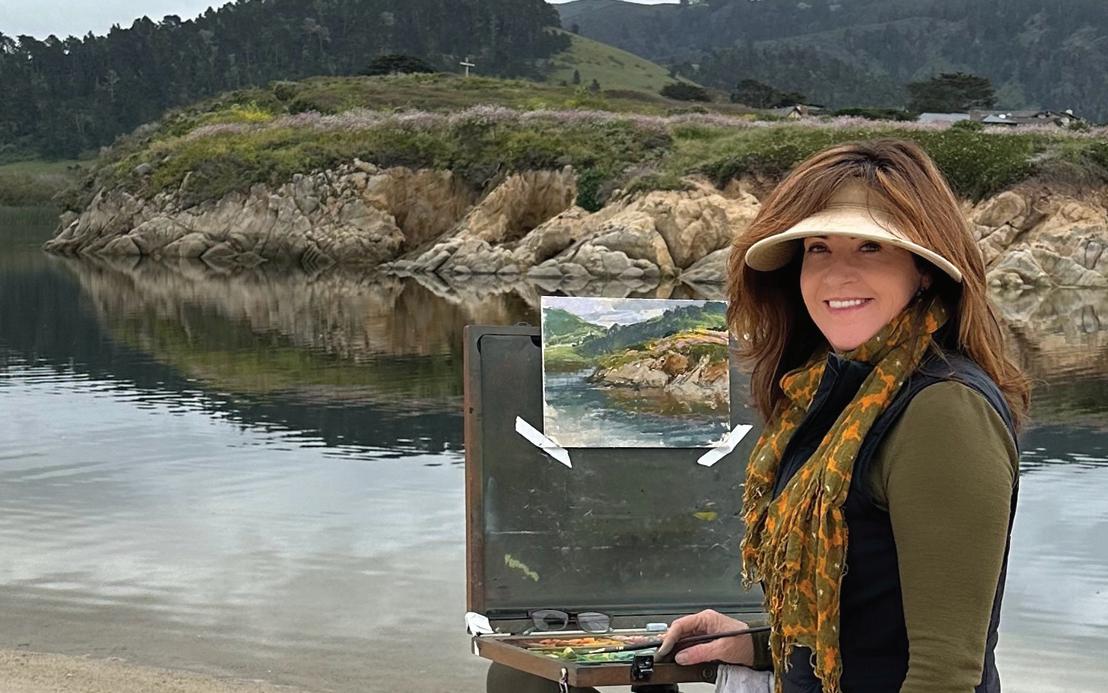

Kim is announcing an October 1, 2025 paint-out to “Beat the Heat!” Join fellow painters on the stunning California Coast at Pescadero State Beach. In sun or fog, this stretch of coastline is beautiful! Meet at 9:30 am and find your inspiration. Do some painting, talking, shopping, and hanging out with like minded folks.
Meet up: Southern Pescadero Beach Access Parking Lot (Located at the intersection of Highway 1 and Pescadero Creek Road) Beach Access: The rocky beach is accessible from the northern end of the parking lot by stairs.
Facilities: Two restrooms. No running water. Two picnic tables. No barbeque pits.
Bring your lunch or drive the mile into Pescadero and grab some great Mexican food at the gas station, yes, gas station! Or, get some artichoke soup and a sandwich at Duarte’s, or a deli sandwich at the Arcangeli Grocery Store. See you there!


Date & Time:Wednesday, October 1, 2025 9:30 am to …
Location: Pescadero Beach State Beach Southern Pescadero Beach Access Parking Lot
Contact: kim@kimfancherlordier.com




Bobbye West-Thompson, our steadfast representative from the California Central Coast, San Luis Obispo County region shares news of their recent paint out on May 22 at the estuary in Los Osos. The property owner, also an artist, was thrilled to have Bobbye’s group of seven painters at his lovely water front location. She reports that it was a gorgeous day, with bright sunshine and a "visit" from a local coyote searching for his breakfast. The next paint out will be in September, at either Tidelands Park, Morro Bay or Dinosaur Caves, Pismo Beach —watch for details to be announced later this summer!


The PSWC greatly appreciates our Regional Reps! These artists have stepped up to help the Society fulfill it’s commitment to promote art and art education in our communities and to have a little fun while doing it! They organize Paint-Outs, PaintIns and social events in their geographic areas. If you live in one of these areas, contact them through their websites to find out about upcoming events. Traveling near-by? Here’s a chance to find out about events that will turn your vacation into an art trip! Interested in becoming a regional rep? Please contact us!






REGIONS COVERED
IDAHO, MONTANA, WYOMING
Bonnie Davis Kenaley
SEBASTOPOL, NAPA, SONOMA
Clark Mitchell • clarkmitchellart.com
SAN FRANCISCO AND PENINSULA
Kim Lordier • kim@kimfancherlordier.com
CALIFORNIA CENTRAL COAST, SAN LUIS OBISPO COUNTY
Bobbye West-Thompson • bobbyewestthompson.com
SANTA BARBARA COUNTY
Carol Talley • caroltalley.com
SOUTHERN CALIFORNIA, VENTURA COUNTY
Jean Vineyard Myers • jeanmyers1990@gmail.com
Bobbye West-Thompson’s painting on the easel.
Santa Barbara County Regional Representative, Carol Talley reports that she is holding two paint-in sessions monthly at Illuminations Gallery in Santa Barbara.
Anyone interested in attending may contact her to learn about the dates and details: caroltalley@gmail.com
From left to right: Felice Willat, Linda Burns, Christine Crooks, Meg Ricks and Lynn Weber at Illuminations Gallery


Regional Representative Jean Myers reports a busy schedule of activities planned for this region. Here are the upcoming dates to add to your calendar. Contact: jeanmyers1990@gmail.com
OCTOBER 11, 2025
Date & Time:Saturday, October 11, 2025, 1:00 to 4:00 pm
Location: Point Mugu Beach, 9000 W. Pacific Coast Highway, Malibu
OCTOBER 25, 2025
PAINT-OUT STILL LIFE PAINT-IN: PUMPKINS, OF COURSE!
Date & Time:Saturday, October 25, 2025, 12:00 to 4:00 pm

She’ll have a nice assortment of pumpkins set up on her patio. BYOP (bring your own pastels), she will have extra easels and will provide light lunch and refreshments. Please RSVP to jean at jeanmyers1990@gmail.com and she will provide the address.
NOVEMBER 8, 2025 PAINT-OUT AT PEPPERTREE PLAYFIELD
Date & Time:Saturday, November 8, 2025, 9:30 am to 12:00 pm
Location: Peppertree Playfield,3720 Old Conejo Road, Newbury Park
DECEMBER 4, 2025
SANTA BARBARA ART MUSEUM
Date & Time:Thursday December 4, 2025, 5:00 to 8:00 pm
Visit the Santa Barbara art museum as a group to see the .exhibition, The Impressionist Revolution: Monet to Matisse. Dec. 4, 5:00 to 8:00 p.m. Admission is free only on the first Thursday of the month.
DECEMBER 13, 2025 PAINT-IN PORTRAITURE
Date & Time:Saturday, December 13, 2025, 12:00 to 4:00 pm
Jean will do a portrait demonstration. Bring your own portrait photo reference to work on. A light lunch and refreshments will be provided. Jean has extra easels. Please RSVP jeanmyers1990@gmail.com for address.
Representative Bonnie Davis Kenaley reports that Idaho/Wyoming/Montana regional members of PSWC have been busy! Summer weather came quickly, providing opportunities to paint from morning to dusk.
Bonnie Zahn Griffith, a nationally-acclaimed artist of western landscape, continues to travel across the west, attending several plein air events in Montana and Utah. Her favorite place to paint is the Midway-Heber City area in Utah. Nestled on the back side of the Wasatch range with the Provo River flowing through this valley, one can find unlimited options to paint. More than 130 artists attended the Wasatch Plein Air Paradise, an annual plein air painting competition that is organized by the Midway Art Association. During several days in late June and early July, various events are held, including competitions, paint-outs, and an art exhibition. Bonnie was fortunate to sell several paintings and win a purchase award during the event. She and her easel are now headed to plein air events in Montana and Idaho. Enjoy your travels, Bonnie!
More information about Bonnie and her portfolio is available at bonniegriffith.com/about.




Bonnie Davis Kenaley’s artwork, Iridescent Plumage, a combination of pastel and watercolor mediums was selected for display at the Pastel Society of the West Coast Inaugural National Open Exhibition, “Out of Bounds!” held at the Art Center Morro Bay, Morro Bay, California. Bonnie was also honored to have an artwork selected for display at the PAPI Annual Spring Show 2025: Changing Seasons,” hosted by The Kuna Arts & History Center, which featured 18 artists and 44 pieces of art.










Carrie Cornils has participated in juried shows this season, including the Water’s Edge Gallery held at the Riverside Hotel in Garden City. In May, St. Luke's Boise Campus Art Gallery selected Carri’s artwork to be displayed throughout the hallways of St. Luke’s Hospital. In June, Carrie showcased her artworks outside at Arts and Roses held at Julia Davis Park. Congratulations, Carrie, on your many accomplishments! More information is available on her website at art4sol.com.


Rembrandt Soft Pastels have been the world’s most commonly used pastel since 1924. Each color in the extensive range is made according to a unique formula. The raw materials used for each new batch go through very strict quality control. Rembrandt Soft Pastels are based on the purest types of kaolin and high concentrations of premium quality pigments that offer the hightest degrees of lightfastness.

Those who participate, know that our painting challenges can spur us to set aside procrastination and paint daily, which leads to improved skill, increased confidence, and in the case of a themed challenge, a low-stakes opportunity to explore. Our challenge participants take a photo of each day’s work and post it to the PSWC Facebook page, with the tag for the
February 1–10
COMPLETED
April 1–10
COMPLETED
July 1–10
COMPLETED
October 1–21

day. At the end of the challenge, they post a photo of all ten (or 21 for October) paintings.
Often, the participants prepare for the challenge by setting aside paper in small sizes, a limited palette that fits the theme, and reference photos or materials they plan to use, such as still life set ups or a plein air set up. This way, they are ready to paint as soon as the challenge
Winter Painting Challenge: Make it High Key, Like Mary’s Cup of Tea With this challenge, we experiment with high key paintings by compressing values, using a limited palette, adding small dark accents, using tools to check values. Look for inspiration of high key examples such as those by Claude Monet, Childe Hassam and Mary Cassatt.
Spring Painting Challenge: Borrow Their Magic, But Add Your Own Spin! With this challenge, borrow inspiration from your favorite famous artists by replicating a specific artist’s technique, process or style in your own work. Use cubist forms like Picasso or imitate thick impasto like Van Gogh. You may incorporate similar themes as those associated with artists such as nature (Constable, Monet), identity (Kahlo, Klimt), the human form (da Vinci, Michelangelo), or social issues (Rivera, Goya) but add your own interpretations. Reimagine iconic works in your own style. For instance take inspiration from Monet’s water lilies or Warhol’s Campbell soup cans but inject your own cultural or emotional spin. Take advantage of this opportunity to create new pathways for your own artistic expression!
Sometimes It’s the Silence That Makes the Music Sing With this challenge, practice creating mood, atmosphere, and harmony by using a tonalist or monochromatic palette in a variety of ways by using a soft, muted color palette or using a monochromatic palette, focusing on light and shadow (chiaroscuro), using romantic or naturalistic themes, incorporating soft edges. For inspiration, check out the works of Whistler, Inness, Murphy, and Cullen.
Use this opportunity to commit to nearly a full month of daily painting. Here are some ways to keep the momentum: prepare your paper ahead of time, focus on small works, limit your time to 30 minutes or so, plan to work in a “series” every few days or week, choose one subject and paint it using several different palettes, go to bed each night with the next day’s block-in or underpainting on your easel.
For rules, more complete descriptions, and to participate, please visit pswc.ws/painting-challenges/
starts. If you are planning to join a challenge, consider working small, and limiting yourself in terms of time. Whether it is a 20–30 minute “study” or a limited 2–3 hour finished painting, determine what you will realistically be able to commit to on a daily basis.
Tonalism: Sometimes It’s the Silence That Makes the Music Sing
For July’s challenge, participants practiced creating mood, atmosphere and harmony by using a tonalist or monochromatic palette in a variety of ways by:
• Using a soft, muted color palette with diffused light and subtle color gradations
• Using a monochromatic palette favoring earth tones, browns, grays and soft blues
• Focusing on light and shadow (chiaroscuro) to create depth, volume and mood


• Using romantic or naturalistic themes, such as subdued landscapes
• Incorporating soft edges to create a sense of ethereal space, mistiness and atmosphere
For inspiration, our Challenge Cheerleader Kelly Hine posted paintings by George Inness, Robert Kirkland Mygatt, Justin Worrell, Armando Morales. Brent Cotton, James Abott McNeill, Edward Steichen, Henry Oshawa Tanner, Leonard Ochtman and Whistler’s famous Nocturne series. One of the participating members also shared an insightful article about tonalism from an online source.
As artists posted their varied interpretations, they included comments about their inspiration, materials and choice of subject. As always, they encouraged and supported one another throughout the challenge!

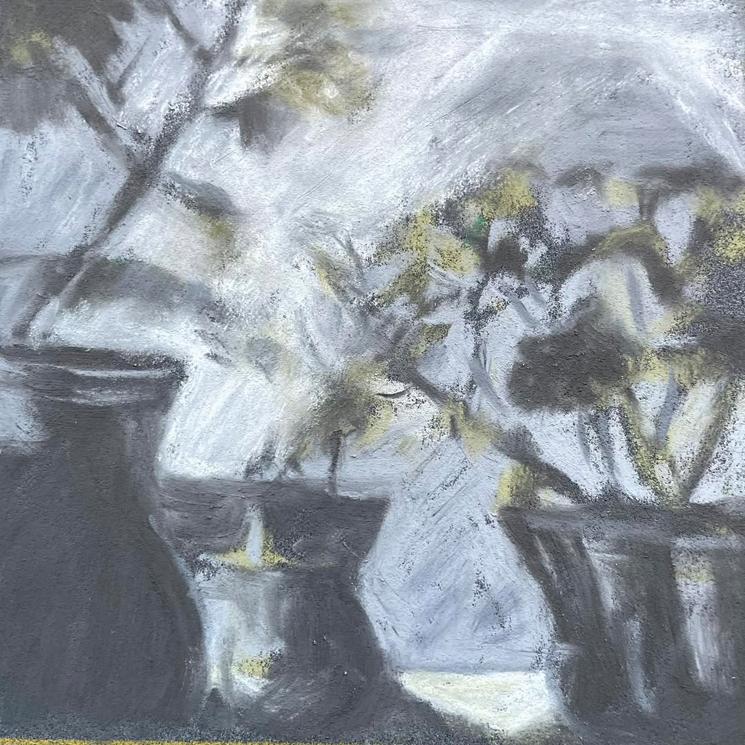

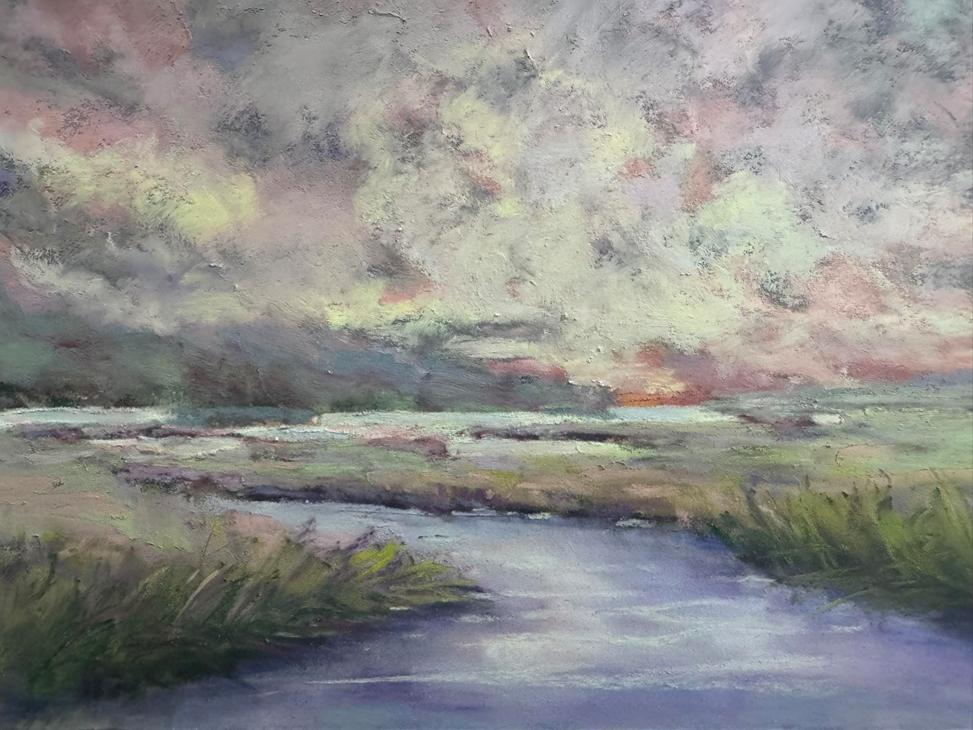




“This was such a great challenge for me but the best part was seeing all the interpretations of Tonalism showing up each day.”
Watch for ‘The Big One!’ our Fall Challenge, which runs from October 1–21, 2025.
For rules, more complete descriptions, and to participate, please visit pswc.ws/painting-challenges/



“I've really enjoyed this one, I learned so much about tonal paintings.”



“the beauty of participating in a challenge is that you get to experiment fearlessly.”




by Pamela Comfort
When I speak with Andrew over Zoom, he comments on how roomy my studio space appears. He shows me his studio space within his relatively small apartment in Vancouver, British Columbia, where he explains, the rent is quite high. Andrew is drawn to the city, however, and has had an affinity for the urban landscape since he was quite young. He prefers street scenes and has always liked what he calls the “hustle and bustle” of city life. He returns from his travels with reference photos from big cities like Shanghai, Tokyo, Bangkok, and New York City.
Pam: Tell us about your upbringing. What led to your interest in art? Did you have a family member or mentor who encouraged your interest or inspired you?
Andrew: I was born in England and moved to Canada when I was about ten. I have one brother and one sister. No one in my family was an artist, as far as I know, I was the first one. My great grandma did encourage me to draw. When I would visit she had an artist friend who would show me her drawings, so that was an influence. I have always been interested in art. When I was young, I recall seeing one of my first images of a painting. I realized that it wasn’t a photo and was fascinated by it. It was a print hanging on our wall of Monet’s painting of a poppy field with a girl holding an umbrella. I remember thinking, “What is this?” Because I knew it


wasn’t a photograph, and even as a young boy, I knew there was something different about the image. I wondered what painting was like and how it was possible to do that.
I took art in high school, just like everybody did because it was an easy grade, but I loved it. I didn’t get serious about it until I was in college. I majored in illustration and design. I got into more and more painting and drawing through that. After that, I realized I didn’t like design. I did illustration for a little bit, and I knew I wanted to just paint and draw. I started getting into pastels pretty early on.
Pam: Your parents were okay with you majoring in illustration and design? How did you make a living once you got out of college?

Andrew: Well, my dad’s old school, so he was always saying, “Just get a union job.” You know, he had a very Northern England, working class upbringing. “Be a plumber.” My mom was fine. She was supportive.
I had a design job for a week. I did a few illustrations. I got a regular job in a grocery store, and just kept painting on my days off. I tried to work part time like 3 or 4 days a week, so that I could keep painting. I got into teaching pretty early after graduating. I was lucky because my instructor got me into a big gallery. I was in a top gallery in the city, so I got into teaching and I was part of the Federation of Canadian Artists (FCA). As a part of that group, I met all of these big artists and they encouraged and supported me. I did my first demon-
stration when I was about 23. I was pretty nervous at the time.
So, I had a job to pay the rent, but I was always painting. My resumé only had information about my art, art shows I’d entered, my teaching, and it looked like I was a professional artist. Which I was, I guess, in a lot of respects.
Pam: Who or what else has had a strong influence on your work?
Andrew: There were some English painters whose work I used to see when I was a kid in Manchester. There was a British artist, Sir George Clausen RA (1852–1944), and particularly his painting Harvest, Tying the Sheaves
(1902). I also loved the city painter from Manchester named Adolphe Valette (1876–1942) and in particular his painting Albert Square Manchester (1910). I was influenced by street scenes, because I got into them pretty early. Of course, I also enjoyed the works of Joaquin Sorolla (1863–1923) and in particular his painting Asturian Landscape (1904).
I also loved some of the illustrators from the past like Bob Peak (1927–1992) in particular, and his paintings of movie posters like those from Apocalypse Now, Blade Runner, Excalibur and Star Trek
Pam: What has been the key to your growth as an artist?
Andrew: Persistence and perseverance, I never believed in plan B, plan B was support for plan A. That’s why my resumé didn’t even look like I ever had a job in a grocery store. It only looked like I was always a professional artist. Financial matters always matter, you must pay bills—so I had the side job when necessary, but I always kept my focus on my end goal.
Pam: Can you describe a moment when you experienced a breakthrough with your technique, or a process?
Andrew: When I was in college I used to have figure drawing classes. We got a box of those cheap pastels, right? So that’s when I first started to use pastels. I’d read in a book or a magazine I can’t remember, where some guy was talking about pastels, and of course there weren’t as many papers as there are now, you know, there were just basically a couple made for pastels. Anyway, this guy said never, ever use black paper.
So I went out and bought every single kind of black paper. This was back in the nineties.
I just experimented. I understood what he meant when I practiced a lot. Then I found one. It wasn’t even a pastel paper. It was an Arches cover printmaking paper, or something like that, and it actually worked. And I started using that. And then you know what’s funny? I went down to my first IAPS convention where I met Maggie Price and other top artists. I saw different pastel artists painting on boards and using washes. I thought, “this is totally different” and “why are they doing that?” But it was good because I had spent a lot of time finding my
own way of doing things through experimentation, before I saw what the big name artists were doing. I think it’s good to experiment and find your own way. It helped me put my own work out there, which was a little bit unique.
We are all influenced by other artists, because no one lives in a bubble. We are on Instagram, YouTube, whatever. But it’s important to do a lot of your own experimentation and to have established a general direction

for yourself. I tell my students to pretend they are on a boat in a river, and they want to go down that river. But the river goes like this (gesturing back and forth in a zigzag), but it still goes in a general direction, right? Know your general direction. Mine is impressionism. I like the fences of impressionism and realism. I like that middle ground. I like going back and forth a little bit, you know, and I generally like those kinds of paintings, anyway. But that’s my general direction, even though I might go realistic on any given day, or go a little bit more expressionist or impressionist. Still, I have my general direction.
There have been a few moments where I feel I have some breakthroughs. Whether it’s my creative process or something technical that I discovered. Using my rubber triangle for texturing is another example.
Pam: Do you use washes or an underpainting at all?
Andrew: I don’t because I feel that I don’t need to. I don’t get the darks in early. I don’t like to do that because I struggle when getting my darks down too early, too soon, because then I end up with too many darks that I didn’t want. So when I started to paint with more
of the mid values first, that really helped me, because then I could better control where the darks went. Everybody’s different. You should find your own way, and it wasn’t for me. I have my own methods of layering in. So, starting with the darks is one of those “rules” that should be thought of as a guideline. Everyone needs to find their own way and enjoy the process.
Pam: What part of your creative process do you find most fulfilling and why?
Andrew: I enjoy the final moments of a painting, the final touches that bring the painting to life.
Pam: Do you ever struggle with stopping soon enough, finding that you’ve inadvertently overworked a painting?
Andrew: Never! You know I've actually had the opposite problem. I used to have the opposite problem, of not finishing it far enough. I’m lucky I learned some of this stuff early on when I was really young. I always believe in under working paintings. Never finish off an area. I always underworked it. I just blocked it in, using shapes and finding my design and finding my way that way. And so I can control where I put the detail. And I


found that helped me a lot. And so I’ve been lucky to have that not be a problem.
My problem was mainly that I could have pushed things a bit further. I could have gone with a little bit more detail, maybe. But I get that now. Early on I didn’t.
I do often hear that from students. They always talk to me about not knowing when to stop. They just keep going and going. That’s why time limits are good. You just put 30 minutes on the clock. Paint, and when the timer goes off…boom. Stop.
Another idea students struggle with is making a mark and leaving it alone. Sometimes, you can put a mark down, and it might not look good in isolation. But it might suit it when it’s done. Same as when you under-
paint sometimes. Oh, I got this area of color coming through it. This seems not polished yet or underworked. But then, by the time you finish it, well, actually, this color coming through looks good now.
You have to understand that process. Then, when it’s nearly finished, they can always go in a little bit where they want to go back in if they want to. Trust the process. There’s so many ways to go about a painting right? Ultimately, it’s the end result that matters.
Pam: What are you working on right now?
Andrew: I’m working on two shows right now. I’m working on a group show in Taipei, Taiwan. That’s 12 paintings. And then I’m working on a solo show the same month in Shanghai, and I have to do 36 paintings

for that one. So 48 works mostly pastel. Everything I’ve been working on lately is for these shows. They are in August, so I have not had time for anything else whatsoever.
The show in Taipei is through Pastel Art Promotion Association Taiwan (PAPAT) and is by invitation. I will have 12 pieces in that group show and I’m going there in person. I’ll be doing a demonstration, and then right after that I go to China, for a show at the Ming Gallery in Suzhou which is about an hour drive from Shanghai. The population in Suzhou is about 8 or 9 million. Very few have heard of the city before, even though it’s a
huge city. A number of well-known pastelists have been there for the Biennial International Pastel Art Exhibitions and solo shows such as Alan Flattmann, Liz Haywood Sullivan, Jimmy Wright, Olga Abramova, Richard McKinley, Desmond O’Hagan, Tony Allain and more.
I have a solo show there of 36 paintings. I’ll be teaching as well. The space is beautiful, and all of the art is really high level.
Pam: And they treat you like royalty?
Andrew: They sure do. I’ve had a show before in China many years ago. I shipped 10 paintings.They usually keep
one painting. For that one painting, they paid for my flight, hotel, and my food. This was for 6 days and in this case, they actually bought the paintings before I even shipped them. They sent me the money before I left for China and paid for my expenses.
For the 36 I am sending to this show, I am bringing them unframed and they are framing them at their expense. They will show them for about six months to a year, and they rotate them. Then, whatever doesn’t sell they will pay to ship back to me. So, it’s a no-brainer.
This time they are paying for part of my flight, but I am not paying to ship because I’ve figured out how to bring the paintings with me on the plane. I’m allowed 2 check-ins and my portfolios fit. I measured the size and weight. I’ll just make it so I won’t have to pay for shipping! The largest one is maybe 20 x 30 inches. A few are 16 x 20. The portfolio is the way to go, because the shipping to Taipei was $250 and that was only 12 pieces, this is 36. I’ll take photos of the pieces and measurements, and they will be ready to frame them when I arrive.
I’ve been so busy, this is the first year I haven’t been able to enter the Pastels USA: 99 Voices Exhibition. I have 30 paintings done and I still have 6 more to finish. I will leave in a month and I have compacted all my teaching so I could take August off. I have all of this extra work to finish before I go.

Pam: You teach at the Vancouver Film School, and also other classes. What is your daily schedule like?
Andrew: I teach in a few places. I teach at Capilano University, which is where I graduated. I teach at Vancouver Film School, which is animation school. They call it film school, but they also have acting and a huge animation department. So students can take classical animation and concept art. There’s a foundation program
with 3D animation and stuff like that. So they have a lot of drawing classes for classical animators and concept artists, basically. So I teach drawing, figure drawing and painting for those departments.
I also teach my own workshops too, right? In person and online, because it keeps me in it, and it keeps me doing it, and pushes me to learn more. It keeps me fresh, you know. As long as I have time. Desmond (O’Hagan) always said that too. He always says, “Make sure you have time for you, for your painting.” It's important.


On an average day, sometimes I only have one class, sometimes two, sometimes the odd time three— well usually let’s say, I have two classes. They will be two 3-hour classes. One might be drawing, one might be painting. Some of those days I don’t do a lot of painting on my own. If I only have one class, though, I’ll usually paint cause it’s only three hours. I’ll go and teach the three hours, then come back and paint. Especially when it’s for shows like I’ve been working on now.
If there are no classes, I’m basically just painting in the morning. I usually take the afternoon off, especially in the summer, just to go for a walk and stuff. Then I might do some work at night as well, so I split it up. That’s basically my daily routine. I only take days off painting
and drawing when I’m traveling but even then I’ll be working, because I’ll be doing demonstrations and teaching.
My last week coming from Bangkok, I found a couple of places to do drop in figure drawing. So I’m just going to drop in and do some figure drawing just to change the scenery up a little bit. Then I’ll come back and be in full swing, teaching and painting again. Hopefully, I’ll enter a lot of shows next year, after this solo show is done. Solo shows are a lot of work, man!
Pam: So, when are you buying groceries and cooking dinner and doing the laundry and walking the dog and watering the house, plants, and…?
Andrew: Right. Well, I cut back because I’m not allowed pets. So now, I don’t have a plant and it’s just basically my art. But yeah, you have to eat and do laundry and stuff for sure. You have to do household things. But you know, I have students saying, “Oh, I'm too busy. Life gets in the way!” I say, yeah, sure it does. Everyone has to do laundry, and you have to tidy your house up once in a while for sure. I get it. But do you have five minutes in the day? Yeah, I have five minutes. Okay. Well, you draw for five minutes.
That’s it. That’s it. That’s all. You know what? Even a minute. Everyone has a minute. Come on, get your easel set up, put a timer on one minute, and do something.
That’s all you have to do. It’ll probably be more like two or three minutes, anyway, and at least you’re doing something. Put it down right, because otherwise you just get in a trap of thinking about it all the time. And that’s good, too. It’s good to be a creative thinker for sure, but you’ve got to actually do it.
I can imagine I’m going to be the best golfer in the world. I can visualize it all I want. But if I don’t golf, it’s never going to even get close. How am I going to get close? I’m just delusional. Yeah.

But pastels are messy, too. You’ve got to clean it up a lot, right? You’ve got to clean your pastels up. Of course, I spend time cleaning my pastels out once in a while. Usually as soon as I finish painting, I’ll spend time cleaning. And if I don’t want to paint today, that’s when I’ll do all the other stuff. I’ll clean my pastels. I’ll make sure my space is right. I’ll mark off some boards because there’s a lot of prep work, Pam, you know that you’ve got to get the boards cut or paper cut or get your refer-
ence photos in order. Plan ahead. Maybe a couple of paintings, especially if you’re having a show. So there’s always stuff to do without actually painting, for sure. So if I don’t feel like it, that’s when I do that stuff.
Pam: How do you handle creative blocks and what helps you push through them?
Andrew: I go to a quote of mine that I still live by “It is better to paint for one minute a day than to think about it for 24 hours a day; one learns more in that one minute of painting than in thinking about it for 24 hours.” Don’t think too much just start…. Also, I feel deadlines help, I look at show entry deadlines to enter and this helps me paint for them.
Pam: You have achieved great success and a widely respected reputation. What has been one of your most rewarding experiences as an artist so far?
Andrew: Well, its funny you get to a point over many years of hard work, and realize you know a little. I really feel rewarded when I win an award and/or get published, getting small recognitions from artists you love is very rewarding.
Pam: Your work evolved over time. What are you looking forward to in the future?
Andrew: I want to evolve my art over time, so yes, I wouldn’t want to think I can’t grow as an artist, aim for the stars the sky is endless. I have always enjoyed being on the fence between realism and impressionism, so I have aim and direction, I just take the scenic route.
The ultimate goal when I do retire, is I’m going to probably switch it more, and probably do more painting outside. That’s my plan. I have done it before, and I like it. The only reason I don’t do it now is because I just like



my life right now, in the sense that I still like figure drawing from life. I want to do that for a little bit longer. And I like studio painting as well.
So down the road I’ll switch the figure drawing to do more plein air. That’s the plan.
Pam: What is one piece of advice you would give to your 20-year-old self?
Andrew: Don’t worry about rejection, paint what you want to paint.
Pam: What is it that you wish people knew about Andrew McDermott that they may not know?
Andrew: That I took no short cuts and spent more time internally working at my craft than looking at others paint. Also that I draw from life 4–6 days per week.
Pam: Any parting words of wisdom for our readers?
Andrew: I got nothing, man, I got nothing! Well… I always say to people, don’t worry too much before you paint. People stress out about it. What are you stressed out about? It’s because they want it perfect, that’s what it is. They want to create the masterpiece. You have got to get that out of your head. You just have to go into it thinking “this is a practice piece.” If you go in thinking it’s a practice piece, I’ll tell you something, it means
you’re going to be able to take chances because it’s practice. Maybe you’ll do something you’ve not tried before, and yes, it might not turn out. But often they do.
If you worry too much and you stress out too much, you get too tight. Painting is relaxing and fun. Keep it that way. Yeah, we all want to get better. Right? That’s the beauty of it. But then it never ends, and that’s great, too. You can’t expect to paint for a year, and paint as well as someone who’s been painting 20 years. How is that going to happen? I don’t care how talented you are. It doesn’t happen that way. It’s a time game. So that’s just the way it goes.

Andrew McDermott served as President of the Federation of Canadian Artists (FCA) for 8 years, and was on the board for 12 years. With a membership of about 2,500, the FCA is the largest art society in Canada, a nonprofit. He has won many top awards in both Canada and the U.S. and has been featured in numerous published articles. Andrew has been named an Eminent Pastelist by the International Association of Pastel Societies, and he is a Signature Member of the Pastel Society of the West Coast. mcdermott-art.com


PSWC offers a comprehensive program of status levels designed to encourage and inspire artistic growth and reward talent and hard work. Members earn points when competing in our three annual PSWC competitions, PASTELS USA: 99 Voices, MOOS (Members Only Online Show), and Out of Bounds! Multi-Media Show. Any member receiving any status distinction must be a member in good standing with membership continuous since joining society and dues paid and current.
NEW 2025 SIGNATURE MEMBERS*
Congratulations to
Lynn Folse Attig, PSWC
Dawn Buckingham, PSWC
Jay DeChesere, PSWC
Louise DeMore, PSWC
Francesca Droll, PSWC
Carrie Givens, PSWC
Karen Glancy, PSWC
Kelly Hine, PSWC
Inge Ivens, PSWC
Diann Johnston, PSWC
Glen Maxion, PSWC
Natalie Richards, PSWC
Deborah Shea, PSWC
Anne Spivey, PSWC
Teresa Steinbach-Garcia, PSWC
Nori Thorne, PSWC
Avon Waters, PSWC
Bobbye West-Thompson, PSWC
Christina Williams, PSWC
THE LEVELS ARE AS FOLLOWS
Signature Member (PSWC)
There are two ways to achieve Signature status:
OPTION 1
• Member receives place award in Members Only Online show (MOOS), or Out of Bounds! show and
• Member receives acceptance into two Pastels USA: 99 Voices shows
OPTION 2
• Member is accepted into three Pastels USA: 99 Voices shows
Once the Signature status is earned, member may use the letters PSWC after his/her name.
Distinguished Pastelist (PSWC-DP)
• Member has achieved signature status in PSWC
• Member receives awards in three Pastels USA: 99 Voices shows in five consecutive years.
Member may use the letters PSWC-DP after his/her name
Elite Pastelist (PSWC-EP)
• Member has achieved Distinguished Pastelist status in PSWC
• Member receives additional awards (separate from DP) in three Pastels USA: 99 Voices shows in five consecutive years
Member may use the letters PSWC-EP after his/her name
Pastel Laureate (PSWC-PL)
Member may use the PSWC-PL after his/her name
Pastel Laureate is determined by the PSWC Board based on protocol for this award and multiple considerations such as:
• Member has achieved Elite Pastelist status
• Member receives additional awards (separate from EP) in multiple Pastels USA: 99 Voices shows
• Member has taught the art of pastels for a five or more years
• Member has published a book or has been included in a publication of merit related to pastels and pastel art
• Member has made a significant and lasting contribution to the art of pastel painting
*A recognition for all members achieving new status levels in 2025 will be held during the final General Membership Meeting of the year, via Zoom on December 14, 2025.










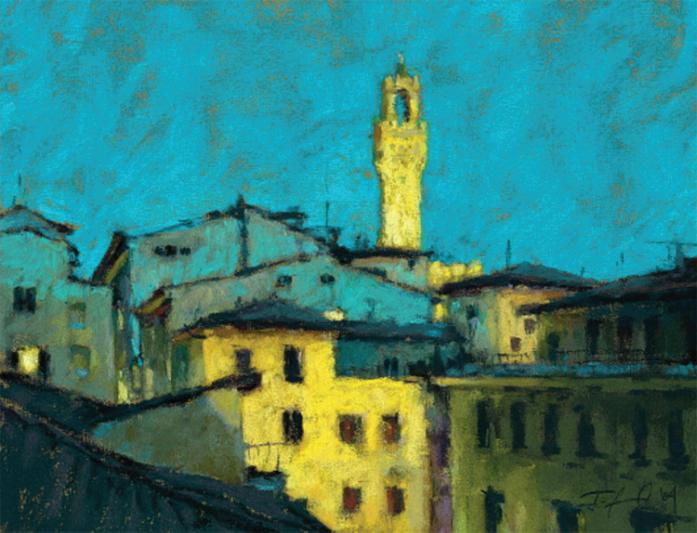


September 6, 2025 5:30 – 8:00 pm
There’s something extraordinary about seeing pastel artwork up close—where light dances across the surface, colors hum with emotion, and textures leap from the paper like whispers of the artist’s hand. Online images can hint at beauty, but they flatten the delicate layering, the subtle luminosity, and the sheer presence of the work.
At the Hilbert Museum’s Pastels USA: 99 Voices Awards Reception, you’ll step into a space where every stroke reveals its depth, intention, and soul.






HILBERT MUSEUM OF CALIFORNIA ART at CHAPMAN
UNIVERSITY
August 23 to November 29, 2025

The 39th Annual International Open Exhibition of PASTELS USA 2025: 99 Voices in Pastel is officially open at the prestigious Hilbert Museum of California Art as of the publication of this magazine. Congratulations to every artist whose work is represented! As always, it took an extraordinary amount of time and effort to put together an exhibit of this caliber, and we extend our appreciation to everyone who contributed to that effort. Pamela Comfort continued to provide leadership and guide the process, while also stepping in as the lead person on Ways and Means, securing all of the donations for the awards. This year’s exhibition chair, Lynn Attig came to the job with plenty of experience, and that served us well. Mary Platt, Emily Valdez and the staff and volunteers at the Hilbert did an amazing job of making sure no detail was forgotten—Thank you! Finally, our deep gratitude to our wonderful slate of jurors, Marla Baggetta, Michael Freeman, and Sandra Burshell for taking such care when thoroughly evaluating the entries, and to Colette Odya Smith for her wise expertise and judgment when assigning awards, and her illuminating commentary.
JUDGE

Speaking of awards, this year’s awards reception will be taking place on September 6, 2025 and for that reason, award-winning paintings are not identified in this issue. Awards will be announced at the reception and on our website following the reception. Our December issue of PSWC Magazine will include a special section for recognition of the award-winning works, as well as recognition of those members who have achieved a new membership status level based on receiving an award in the show.
We appreciate each and every artist who took the time to enter work in the show. We all know that despite all efforts, judging is an imperfect process—therefore, subjecting our precious art to such scrutiny is no small thing. We applaud all of you who took the risk and whether your work is shown in the following pages or not, we are honored that you allowed it to be considered for this exhibition. Let us all remember Natasha Isenhour’s wise words from our last issue’s article, on the judging process, “…paint what you love, and paint from your heart!” and “Creativity defies absolutes…” Just paint.


Judge of Awards, Colette Odya Smith is a lifelong Wisconsin native, and a painter of contemporary landscapes that often blur the distinctions between realism and abstraction. She earned her degree in Fine Art, Humanities, and Education at Macalester College in St. Paul, then taught public school art and raised two children. A pastel class at MIAD, the Milwaukee Institute of Art and Design, set her on her career path for more than 30 years. Her paintings have been featured in several books and art publications and exhibited widely in the United States, France, Germany, and China. They have received over 70 regional, national, and international awards. Ms. Smith has written articles and juried for the Pastel Journal and The Artists Magazine. She has judged the prestigious international exhibitions of the Pastel Society of America and the International Association of Pastel Societies (IAPS). She has been honored as a Maître Pastelliste by the Societe des Pastellistes de France, Master Pastelist and Advisory Board Member by the Pastel Society of America, Eminent Pastelist and Masters’ Circle member by IAPS, and Distinguished Pastelist by the Pastel Society of New Mexico. Her work hangs in public, corporate and private collections, including the Ming Gallery Museum of Pastel in Suzhou, China. She offers her work in the spirit of service.



Juror, Marla Baggetta is a nationally acclaimed artist, a gifted instructor, and a pioneer in the realm of online art education. With a career spanning over three decades, Marla's artistry has flourished in pastel, oil, and notably, abstract acrylic. Marla honed her skills at the Art Center College of Design in Pasadena, California. Following her graduation, she embarked on a successful 20-year journey as a commercial illustrator. Marla's contribution to the art world extends beyond her paintings and workshops. She is a signature member of the Pastel Society of America and an International Association of Pastel Societies Master Circle Recipient and a member of the American Impressionist Society, Her paintings have been featured in several books and publications and exhibited throughout the United States. She has been featured in the Pastel Journal, Plein Air Magazine, the Pastel Society of the West Coast Magazine and is the author of Step by Step Pastel by Walter Foster Publishing. She has judged the prestigious international exhibitions of the Pastel Society of America and the International Association of Pastel Societies.
JUROR


Juror, Michael Freeman is an international award-winning hyper-realistic pastel artist from New Zealand. He has had a fascination with realism since childhood and in his paintings, he is always striving to create greater depth and feeling than can be achieved with a photograph. Michael is in an Eminent Pastelist in the International Association of Pastel Societies, Master Pastelist in Pastel Artists of New Zealand, Master Pastelist in Pastel Society of Australia, Signature Member in the Pastel Society of America, and has an MFA (University of Illinois). Michael went to Elam School of Fine Arts (University of Auckland) to be a painter and left a product designer. However, after a long successful design career he decided to return to his passion for painting in 2010, starting initially with acrylics, before discovering the wonderful medium of pastel. Michael has won many awards internationally and has been exhibiting his work regularly since 2015. Michael and his wife, Julie, together teach workshops internationally and provide mentorship as Mastrius Master Artists.
JUROR

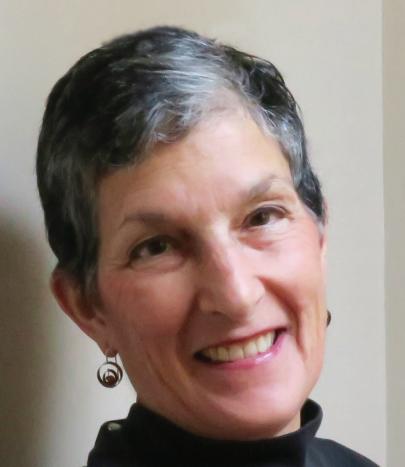
Juror, Sandra Burshell is an Eminent Pastellist in the International Association of Pastel Societies (IAPS) and a Master Pastellist in the Pastel Society of America. Her award-winning moody, atmospheric, and figurative pastel interiors have been exhibited internationally. Her pastels have been featured in many leading art magazines, such as Pratique Des Arts’ Special Pastel Issue, Pastel Journal Magazine, Pastel Artist International, Artist’s Magazine, and American Artist Magazine. Sandra was the IAPS Vice-President from its inception in 1994 through 2006, and a Degas Pastel Society Signature Officer. She has been represented by Carol Robinson Gallery, New Orleans, LA, for over 25 years. She was one of thirteen female U.S. pastel artists at the “Pastels of the World, Orangery of the Castle of Louviere, in Bourbonnais, France, 2022. Sandra is the founder of the New Orleans Drawing Group (2005), a weekly figure drawing session, now in a Zoom format. Sandra gives pastel workshops nationally.
The Pastel Society of the West Coast extends our appreciation to the following organizations and individuals who sponsored 28 awards totaling $17,154 in prizes:
DonorAmount
Streamline Publishing$4,400
Pastel Society of the West Coast$3,000
Royal Talens
FASO/BoldBrush

$ 992
$ 644
PaintingLessonswithMarla.com$ 600
Sabrina Hill$ 600
Earthberry Pastels$ 600
Dakota Art Pastels$ 600
Pamela Comfort$ 500
Goodmundson Family$ 500
Pastel Painters Society of Cape Cod$ 500
Schmincke$ 458
Terry Ludwig Pastels$ 380
Jack Richeson & Co., Inc.$ 341
HK Holbein$ 310
King of Frames$ 300
Clairfontaine Pastelmat$ 295
Pastel Society of America$ 250
Connecticut Pastel Society$ 200 ShowSubmit$ 200
SA Kushinka$ 200
Blick Art Materials $ 200
Golden Peak Media $ 164
Bobbye West-Thompson$ 150
Airfloat Systems$ 150
Armadillo Art & Craft $ 140
Ampersand Art Supply $ 100
Pat Stoddard Aragon$ 100
Deborah Pepin$ 100
Upstairs Art Gallery$ 100
Diane Townsend Pastels$ 80

It is a true pleasure to welcome the Pastel Society of the West Coast’s PASTELS USA: 99 Voices in Pastel, the 39th Annual International Open Exhibition to the Hilbert Museum of California Art at Chapman University.


Pastel is one of the most luminous and emotionally immediate of all painting media—pure pigment held together by just a trace of binder, resulting in vibrant color, velvety texture and a depth of expression that is unlike any other medium. Many visitors to the Hilbert Museum have been amazed to discover the beauty and power of pastel painting for the first time. Indeed, the Pastel Society’s 2022 Voices in Pastel exhibition here was a resounding success, drawing in audiences who were captivated by the richness, delicacy and boldness that pastel artists can so skillfully convey.
We are deeply grateful to the Pastel Society of the West Coast, an organization that has long championed this distinctive art form and nurtured a thriving community of artists. I would like to extend special thanks to Society President Pam Comfort, Judge of Awards Colette Odya Smith, and jurors Marla Baggetta, Michael Freeman and Sandra Burshell for their thoughtful and discerning work in shaping this exhibition.
We also look forward to the exciting programs the Pastel Society will present during the run of the show—workshops, lectures and other events that will deepen the experience and broaden the understanding of this captivating medium.
Finally, on behalf of our museum founder Mark Hilbert and all of us on the staff of the Hilbert Museum, we offer our heartfelt thanks to the artists whose work brings this exhibition to life. Your 99 Voices resonate through your brilliant pastel creations, and we are honored to share them with our visitors.
Mary Platt Director,
Hilbert Museum of California Art at Chapman University
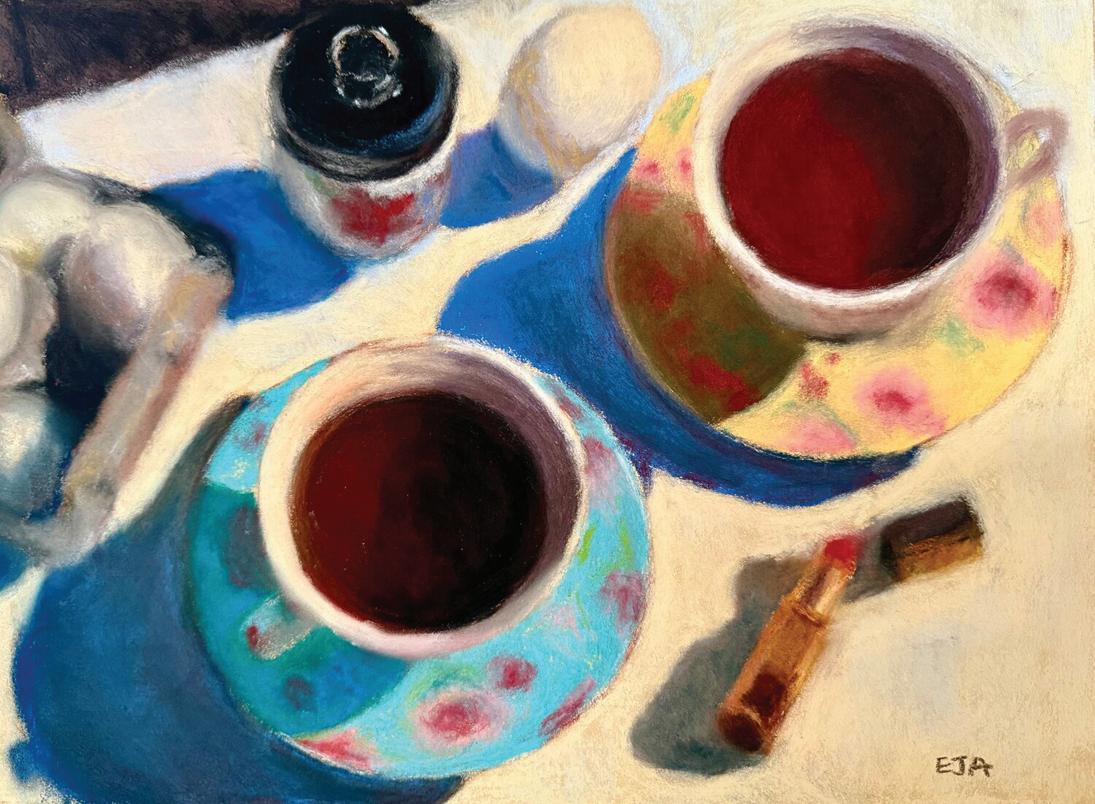
Morning Routine
Elizabeth Amacher, Colorado Springs, CO

You Fell For HER?







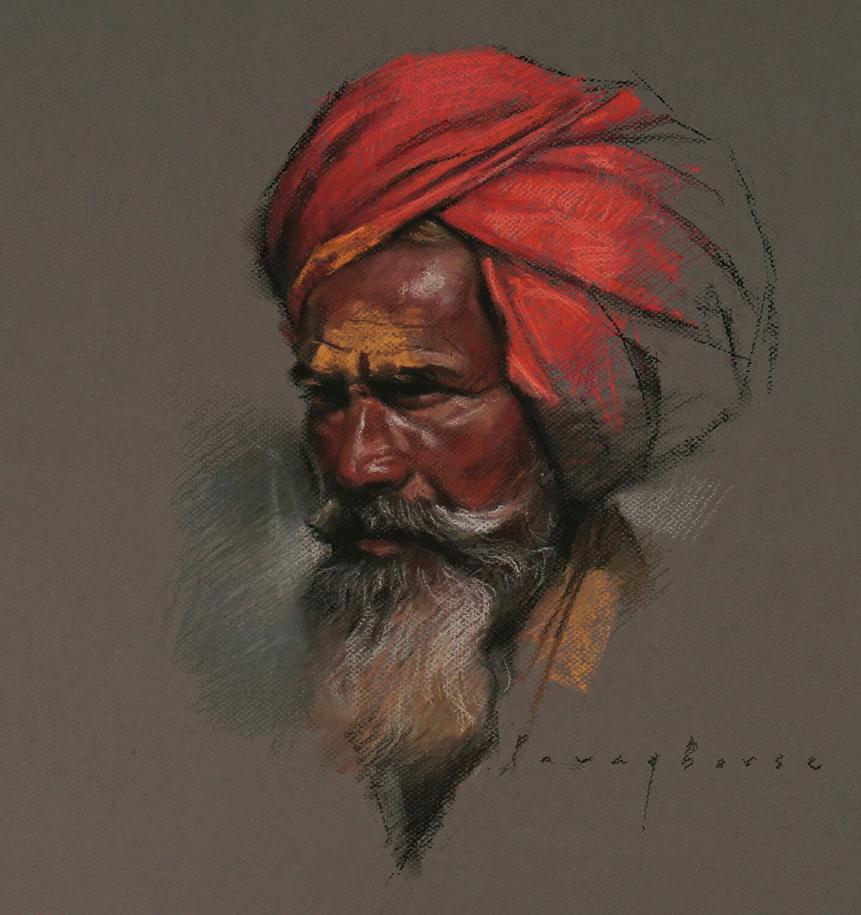



















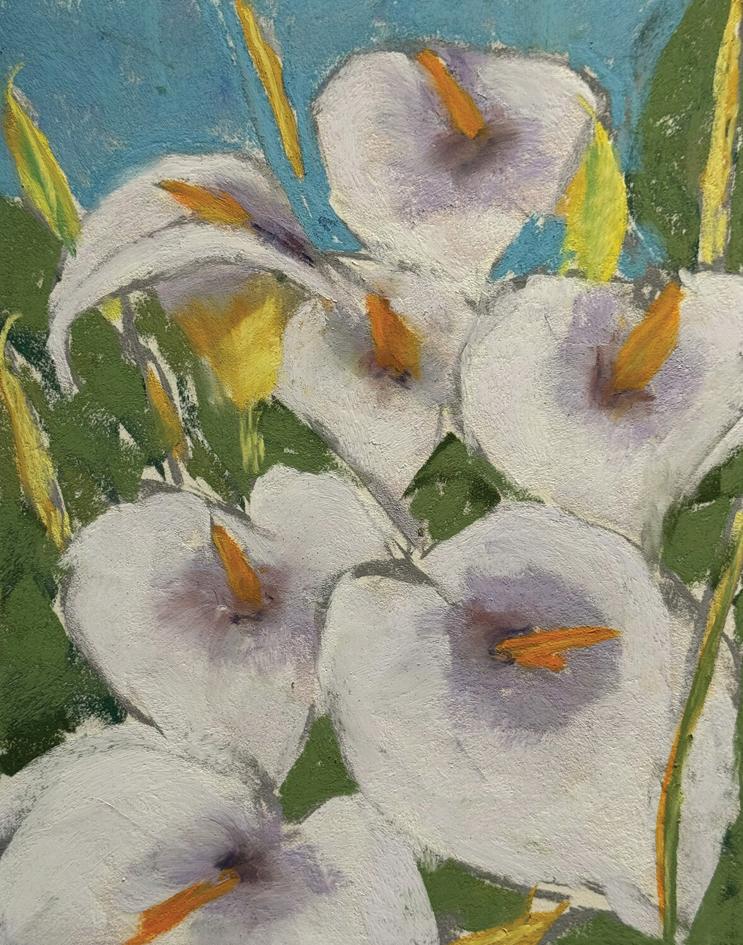





























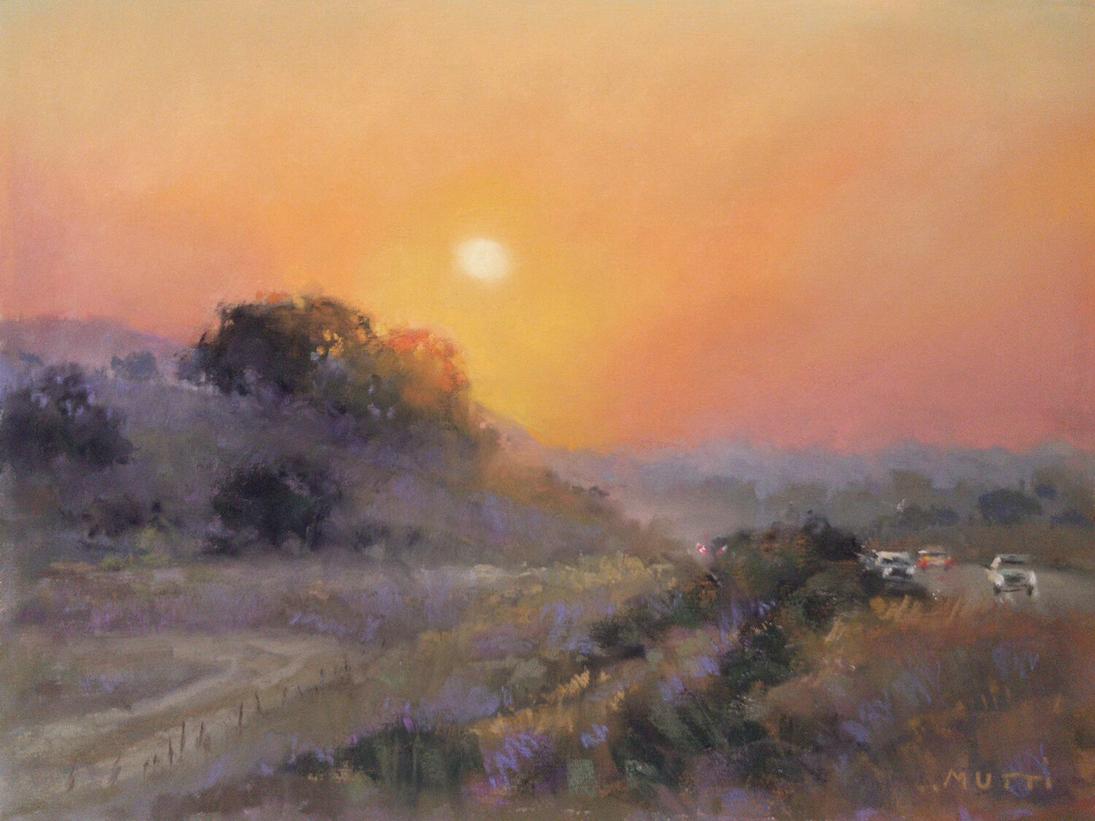

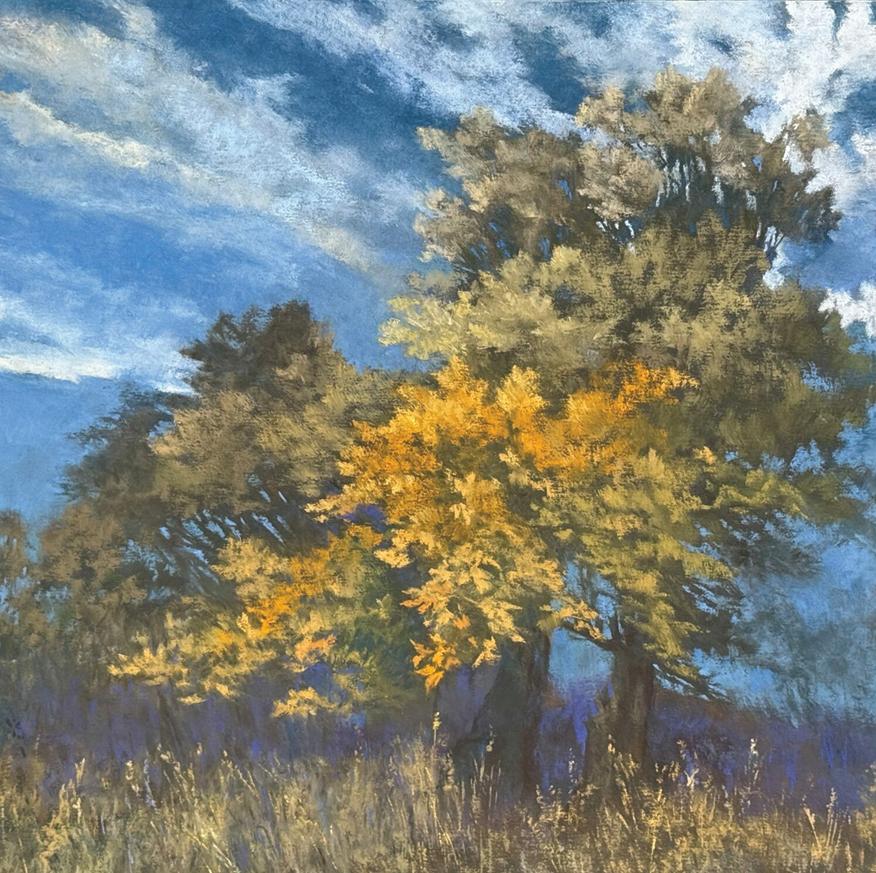


Remembering











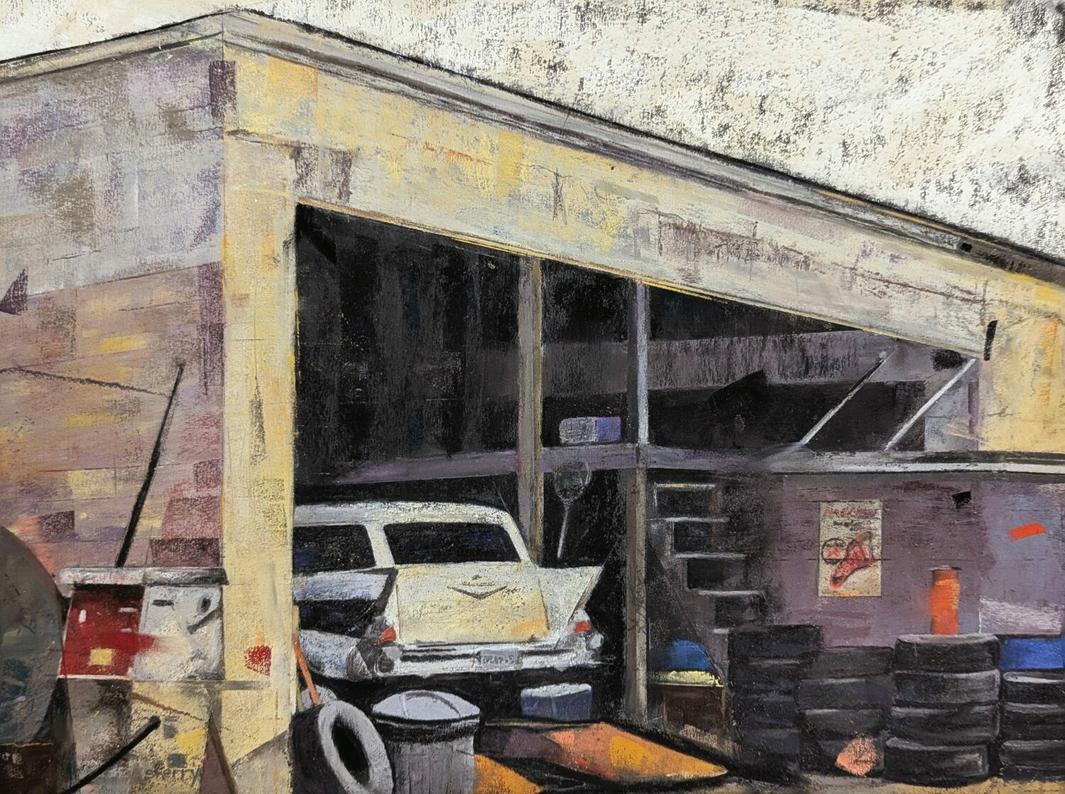





















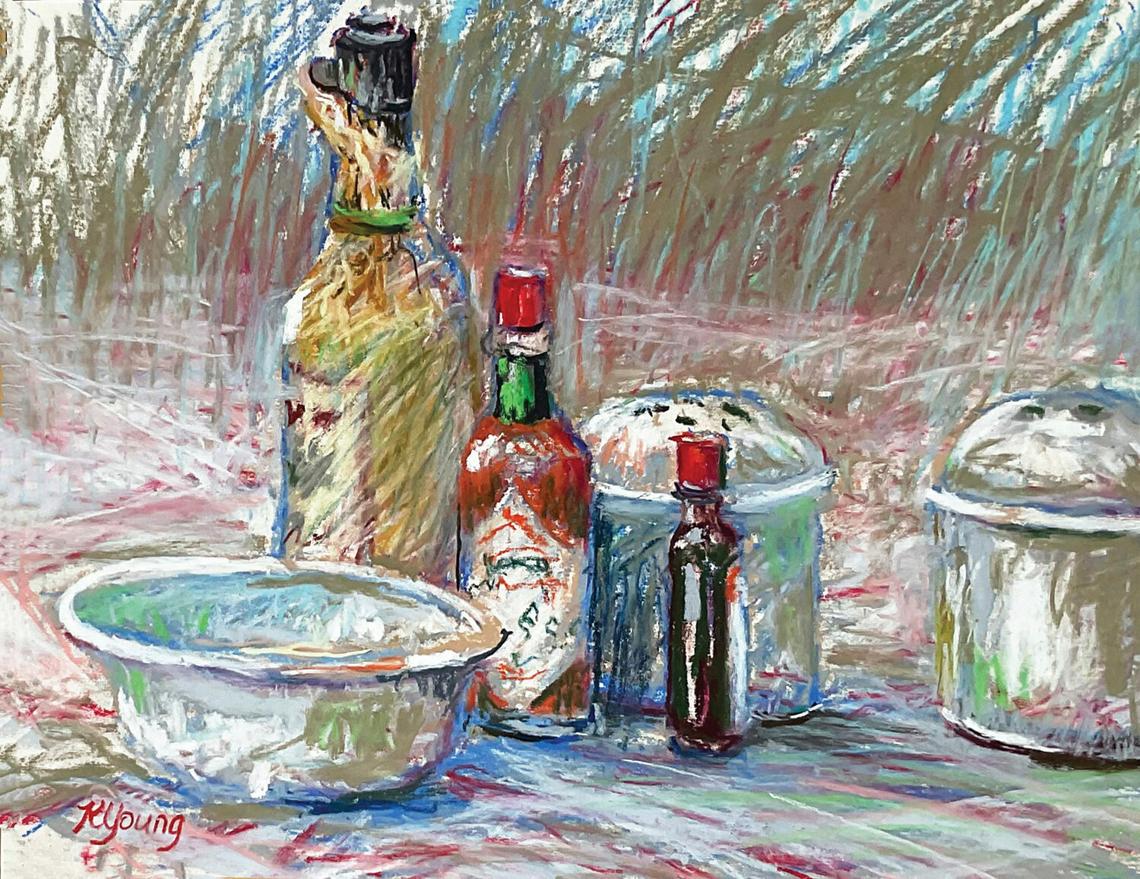

A very special thank you to our Individual Sponsors for their generous cash donations!

Goodmundson



FABER-CASTELL
HOLBEIN
PANPASTEL
SENNELIER

LUXARCHIVAL
PASTELGRAIN


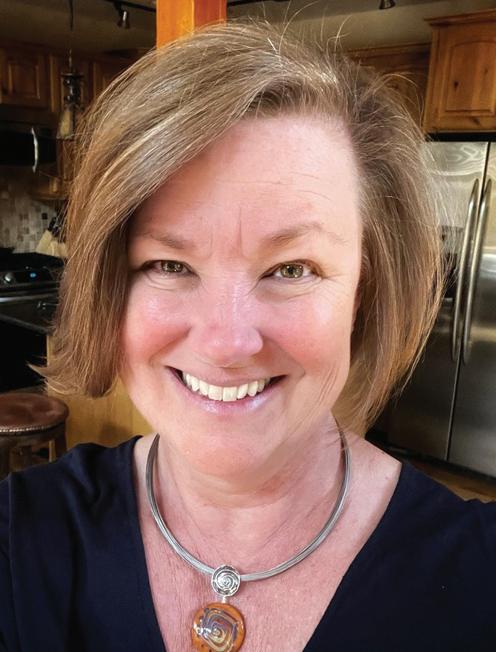










The Pastel Society of the West Coast is a bit of a misnomer. At least, the West Coast part.
As the second largest pastel membership in the United States, our membership pulls not only from all over the country, but all over the world.
This issue’s Meet the Members section features a few artists, including myself, who call other countries our part-time or full-time homes.
By Kim Essex | Images by Kim Essex © All Rights Reserved


As I’m writing this, I am looking out the balcony doors of my twobedroom flat in the old center of Valencia, Spain. We rented this apartment because of the views: Multiple classic, Spanish, blue-tiled domes; a Valencian flag flying atop a gothic tower belonging to the 15th century silk exchange; and a whimsical weathervane sprouting from the Mercado Central.

This is exactly what I dreamed of when I pictured myself painting into retirement—or as the Spaniards call retirement, jubilación. Such a better word.
I would test the theory that I have ‘art’ in my genes. My grandfather, mother, aunt, brother and niece are all artists. So, after kids and a career not related to art, I would pick up the soft pastels I coveted for the same reason many of us are drawn to the medium—the immediacy, the vibrancy, the tactileness’—and paint!


Well. I have yet to paint this scene from my balcony. But to be kind to myself, I have sketched it, and a year and a half later, I am beginning to get up the nerve (and skill, maybe?) to paint it.
As a childhood friend recently said to me, “My memory might be fading, but I don’t recall you being in my art classes in high school.”
I wasn’t. Nor did I take any art classes in college. But I did grow up in a home where my mom studied art, painted watercolors and had friends over to squint at the art on our living room walls and ponder value.
But because my living room education would not a painter make, I bought Marla Baggetta’s ‘Pastels for the Serious Beginner’ along with Sennelier’s Paris Collection in 2023. I started at the beginning: An apple. And my husband declared it was a pretty good apple.
That said, it took me a while to really commit. The transition into retirement, into another country, into a different language and different routines sounds over-the-moon charming, but it’s a hard shift, too. My body needed to find its sea legs in this new-old world before I could find my artist self.
Fast forward to today, a year and a half later.
• I bought a proper studio easel as well as a plein air pastel easel and box.
• I have expanded my pastel box to include Unisons, which I think are my favorite; Terry Ludwigs, which I have the unique opportunity to buy from their operation in Colorado when I am back in the States—fun!;
Jack Richesons; Giraults; Rembrandts; Nupastels; and a few Schminckes. Because my access to various pastel brands is limited in Valencia (primarily Rembrandts and Senneliers), I order online from Dakota or Amazon and have them shipped to a friend or family member so I can pick them up when I’m back in the States.
• I met Marla ‘live’ and found ‘my tribe’ at a pastel plein air workshop she hosted in Florence, Italy.
• I have a once-a-week paint date with one of my besties from the Florence workshop as well as a weekly sketch meetup with a darling French woman who has lived in Valencia for 40 years.




• I have joined an art studio here in Spain where the instructor, Maria, grabs my charcoal and shows me what she is telling me if we’re lost in translation. But she tells me all the time, “Muy, muy bien, Kim,” so I love her.
• I join as many workshops as I can when I’m back in the States—including PSWC’s Desmond O’Hagan workshop in Placerville, CA, and Terrilynn Dubreuil’s workshop in Asheville, NC, among others—because sometimes I just need to be surrounded by artists who speak my language.
• My husband has since asked me if an urban intersection I was painting was a parking lot, so I’ve stopped asking him for his critique.
I guess that means I’m committed, and I’m getting comfortable with identifying myself not only as jubilada, but also artista.





By Kim Essex | Images by Trish Findlater © All Rights Reserved
Ireland has been home to Trish all her life, but when she saw PSWC magazine, she was attracted to the artwork and knew she had to join.
“I was immediately attracted to the possibility of painting in your beautiful location someday,” she tells me about the landscape paintings she saw in the magazine.


trishfindlaterartist.com
Trish evokes all her senses when she discusses the compositions she is drawn to.
“I am thrilled to be able to paint the Irish landscapes and seascapes. I always look for trees, the way they break up the skyline and the way light catches the edges. And I love capturing the full-on lovely shadow and negative shape,” she




says. “In a seascape, I love to have that distant horizon line and a dramatic wave and the canvas of the beach, not just the juxtaposition of the colors, but the sound and the distance.”
She paints in oil and acrylic but says pastels became her ‘go-to medium’ six years ago, after the death of her husband Alex. She was in the garden they built together and felt the correlation of seasonal changes with the seasons of grief, and she needed to paint it. Her soft pastels were the medium she chose for their immediacy.
“Painting the garden in all its seasons—stark winter, exuberant spring, the stately glory of summer and the inevitable decay of autumn— helped her to rediscover the joie de vivre she had shared with her husband,” she describes on her website. She published these artworks in a book titled Grief's Dark Seed and Hope's Blossom
She clearly is an all-weather plein air painter as she described to me painting under a huge umbrella in a squall
or using her car mats to keep her feet warm while painting in the winter.
“I find painting en plein air is a great teacher. Whether painting the sunlit landscapes or the wild dramatic seas and ancient woodlands of home, all have deepened my sensitivity to color values, atmosphere and emotional expression in soft pastel,” she says.
If the weather is damp or wet, she uses oil or acrylic. She is particularly fond of R&F oil bars, using a palette knife or brush or the stick itself.“It’s like oil pastel, but a lot dryer. Very unctuous.”
She has Pochade boxes from Dakota Art Pastel in the United States and Shrub design in Ukraine. “I pack a s|election of color values: highlights, mid-tones and darks and off I go!”
Trish teaches plein air painting and encourages students, to “watch what I am doing with the pastel, how my
wrist is moving like an owl’s head, working the whole thing.”
She jokes with her students that she’ll chop their hands off if she sees them rubbing the pastel into the paper. “It kills the lovely immediacy if you blend. You want the background and beautiful transparency to come through.”
She’s also not fond of drawing a composition before painting a landscape.
“Painting is a series of adjustments,” she instructs. “What I found with drawing out composition first, if you don’t get it right from the beginning, there is a tendency to paint where the pencil mark are and ‘color in,’ but the painting never improves. Whereas with no drawing, if you lay down a wrong mark, you can carve out corrections.”
In 2023, Trish won the Silver Award at Art in the Open in Wexford, Ireland, described as Europe’s largest plein air painting festival, for her painting, “Perennial Bliss.”
Terry Ludwig, Blue Earth, Art Spectrum and Great American are among her favorite pastels because of their edges. But she must pay a significant tariff on many of these brands to get them into Ireland, though she can find Terry Ludwigs in London.
When she reflected on style with me, she had this interesting insight: “Style to me is more like my signature, there is a signature link to my paintings, my mark making, but I want the freedom to respond to the feeling I get on the beach or in the woodland that day, too.”







By Kim Essex | Images by SA Kushinka © All Rights Reserved
(pronounced S A, “like initials but not”) thinks she can still find a floral pastel she did in high school and gave to her mom for Mother’s Day 50 years ago. While she has painted in almost every medium since, “pastel is my medium of choice,” she says.


sakushinka.com
SA and her husband, Mike, are on what she calls the “5-4-3 plan,” roughly five months in San Francisco where they worked before they retired, four months in Kauai where they have a condo, and three months in Italy, where she has been traveling every couple of years since college.
“I paint what I see, wherever I am. For example, the narrow Italian streets dramatically lit or the Hawaiian sunsets and tropical flowers. Those scenes and colors are simply too charming or irresistible <not to paint>,” she insists. That said, this year she is committed to painting more California landscapes.


“I exhibited at a local art fair last fall and someone asked me, ‘Where are your San Francisco scenes?’ Good question!” she reflects. This year she plans to paint the rugged cliffs along the Bluff Trail at Sea Ranch.
Despite her years of experience with soft pastels, she painted plein air for the first time in 2024. The Heilman plein air easel and pastel box has been a game changer, she says. With all the traveling she does, it allows her to set up her studio wherever she is, even in her home in San Francisco. Her calligraphy light table doubles as a backing board.
“Honestly, the hardest thing to figure out is the lighting. Where we stay doesn’t always have the best lighting. I literally bought a light socket that’s attached to a giant cord, and I put a light bulb in it and drape it over something to get the light I need wherever I’m painting,” she says.
A self-proclaimed “workshop junkie,” she has studied with amazing artists such as Loriann Signori and Ian




Roberts along with Marla Baggetta, so much so she is feeling the need to take a break from workshops and absorb the instruction.
“I need to ‘sit with it’ and decide what I want to take with me and incorporate into my work. Some of it might be an approach to painting, or it might be how I think about what I am going to paint and why, or it might be a specific technique,” SA says.
While she has abundant access to beautiful scenes, her struggle is to find the freshness in these iconic Italian, Hawaiian or Californian compositions.
“I am really trying to figure out how to use value and temperature more effectively to convey a sense of freshness and light or depth and mystery,” she explains.
Based on a recent workshop with Signori, SA has recently reorganized her pastel box into values instead of hues. I told her that Desmond O’Hagan also organizes his pastel box by value, and I have done the same based on the workshop PSWC hosted with O’Hagan. We agreed one of the challenges with this organization, at


least in the beginning, is returning your pastels to the right value section after you’ve painted because values are harder to discern by just looking at a pastel.
But, SA says about Signori, “Her work is phenomenal, and she does capture so much light. I’m going to give it a shot, give it some time, even though I’m really itching to rearrange my pastels <back to hue>.” I know the feeling.
You might say SA is a reluctant show enterer. She told me she waited to the 11th hour, literally 11 p.m., to decide which of her paintings to enter into last year’s
Pastel USA: 99 Voices in Pastels. But she entered, and her painting “Sunshine on a Cloudy Day” won the Jack Richeson Award. How affirming!
“After liberating myself from full-time employment (aka, retirement), I really wanted to focus on doing things that bring me joy,” SA says. When she discovered PSWC through Marla Baggetta’s monthly painting community, she was thrilled.
“I was no longer alone at the dusty easel! That connection to a pastel community is immeasurably helpful for personal growth and development.”


By Kim Essex | Images by Judy Miller © All Rights Reserved

How Judy’s first medium—ceramics—became a 46-year career is a fascinating story.


There was a pottery studio in the student union building at UC Berkeley, where she was studying, and she and her roommates needed dishes. “I didn’t know anything about ceramics, but I made us dishes in a very rudimentary way,” she laughs. This happenstance blossomed into a passion for ceramic arts. Decades later, she has sold tens of thousands of ceramic plates, “every single one drawn by hand,” she shared with me.



“I worked in a style that was distinctly my own, and I sold to shops and galleries across the United States and Canada, as well as participated in highly juried arts and craft shows. Using clay as a canvas, and with a humorous touch, I depicted scenes of people living life with a loving spirit,” she explains about her remarkable career as a ceramicist in Santa Cruz, California.
It was at a Santa Cruz County Open Studio tour that she saw paintings by renowned pastelist Kitty Wallis, and she was intrigued.
“Ceramics and pastel. They are both minerals from the earth, both tactile. When I paint, I do feel like I’m sculpting,” she says.
In 2007, she started painting with soft pastels and two years later, she was at a point where pastels became a “serious endeavor.” MEET

“Pastel is such a luscious medium to use. The sticks are so rich with pigment and the sanded paper can hold so many layers that it sometimes feels like I’m sculpting an image. I love holding the stick as it glazes against the sanded surface. It feels like the color is coming directly from my fingertips, without the intrusion of a brush,” she reflects.
Twenty years later and many beautiful paintings of the Big Sur coast, she and her Havana Silk dog Ollie packed up their home in Santa Cruz and moved to Ajijic, Mexico, one hour southeast of Guadalajara on Lake Chapala, the largest freshwater lake in Mexico.
“I highly recommend leaving the country,” she laughs, but she also says this sincerely. “I’ve always gotten my sense of self from my art. I am now really coming into my own as a person.”


Her relocation to Ajijic has invigorated her career, now as a pastelist. She marvels at her success in her new home.
“Everyone knows me, which is kind of amazing. I am very honored to be well regarded as an artist here, in a country with a high respect for art. Pastel is not a very common medium where I live, and people are fascinated by my work,” she says.
Since moving to Ajijic, she has had four one-person shows and has participated in numerous group exhibitions.
She always works in standard sizes from 9” x 12” to 16” x 20,” mostly. She has found a carpenter who builds frames for her in Mexico, but she buys anti-reflective glass and her supplies, for the most part, in the United States and picks them up when she returns for a visit. Her favorite papers are Lux Archival and Pastelmat, and her preferred pastels are Terry Ludwigs, Unison, Sennelier and Blue Earth.
Her paintings are primarily inspired by the ever-changing skies and sunsets over Lake Chapala, but it’s her vivid depictions of Mexican life that capture my eye, I tell her.
“Pastel is such a vibrant medium that is perfect for expressing the beautiful color that is Mexico,” she says.
And yet, she thinks the paintings she did in Santa Cruz were better. Many hang in her living room in Ajijic. As she said this, I thought, this is the curse and joy of being an artist, even for such an accomplished artist, to always be searching for how to grow and be better.
“I have always liked doing figurative work,” she says. She had a figure drawing group at her house for 1½ years. She also has enrolled in Alain Picard’s Painterly Portrait workshop and is part of Picard’s “Cultivate” community, which gives her more structure for learning.
“I have come to a place where I am at in my work. I have to let go of the riverbank and go out to open seas,” she says metaphorically.


By Kim Essex | Images by Lydia Steves © All Rights Reserved

Everyone who knows Lydia knows her for her beautiful animal portraits and her 20+-year commitment to the Ottawa Humane Society in Ontario, Canada, for which she volunteers and fosters pregnant or nursing cats and orphan kittens.


lydiasteeves.com
“I love being part of the shelter’s work giving animals a second chance. Whenever I feel stuck artistically, I always paint a cat or kitten. Gets me right back into the game,” she says.
She started painting animals with acrylics and developed a signature technique for painting fur and feathers with the filbert grainer. She later added colored pencils to her repertoire, and now you might say colored pencils are her breadand-butter.


“I discovered people liked animal portraits, and there were not many artists teaching pet portraiture,” Lydia says. Teaching animal portraiture became her niche.
Recently, she taught an animal portrait class via Zoom that drew artists from coast to coast as a fundraiser for a local animal sanctuary. An added benefit, the sanctuary can auction her painting in the future to raise more money.
She started using pan pastels in 2014 for the backgrounds in her colored pencil work. Now, 10+ years later, she is doing something very different from other artists in her area.


She explained they don’t get the color vibrancy with their colored pencils or watercolors that she gets with pastel.
She describes her pencil work as meeting the needs of other people, such as her students, but her soft pastel work “is just for me.”
“When you use colored pencils, it looks like a photograph, and that’s not what I’m going for. I’m going for a connection with the animal: What is it he wants to do? What is he thinking about doing next? Is he happy that he has that flower bed to himself? He’s the important thing, and I let the background support the story.”
Primarily a studio painter, her inspiration comes from her foster animals and her backyard, which she has slowly changed from lawn to more natural landscape.
“I have bird baths and paths and bird feeders. I never get tired of seeing the birds, chipmunks and sometimes our Bella, a raccoon,” she shares.
During the summer, she paints with a group of plein air artists every Thursday. Her approach is minimalist, which is inspiring.
“I am a classic underpacker and am always trying to see what I can do without. I have a travel easel and a ‘fancy’ box, but it gets heavy to drag around and set up. For plein air here locally, I don’t take the easel, and I keep my pastel choice very small and my paper size also small,” she describes.
On a recent outing, she had a 6” x 8” piece of UArt paper taped to MDF board, and she sat on a bench with the board in her lap and a few Nupastels and
Rembrandts to do a charming study of three children. A forever learner, Lydia has attended several pastel workshops with accomplished artists—from Rita Kirkman to Margaret Dyer and Marla Baggetta as well as multiple Canadian pastelists, including Jessica Masters and Gail Sibley—and she has watched many talks and demos from which she continues to learn about “pastel possibilities.” In fact, she joined PSWC last year and has become a fan of the society’s “We Talk Art” series.
“The overriding tip I’ve gotten is ‘get behind the easel and put in the hours!’ It always seems I’m producing for
a show or working on a commission. I’m trying to spend some time just having fun and developing,” she says. COVID brought her back to the “beginning of my art studies.” She is enjoying life drawing, and she takes a portrait/costume drawing class when Canadian winters kick in. She also enrolled in Alain Picard’s Painterly Portraits online workshop. She is working on expanding her work to include “human figures, a likeness, or a person in a scene.”
“I try to do something every day—sometimes colored pencil stuff. In a perfect world, I spend three days a week painting with pastels,” Lydia says.




Christine Bowman’s love of travel inspires many of her pastel paintings. She enjoys local plein air painting in Southern California and the San Pasqual Valley area near her home. She has also taken many photographs on her various trips to Europe and her home country of Australia. Christine teaches pastel and travel sketchbook classes. christinebowman.com
I started doing a travel sketchbook when I first travelled to Europe.
Over the years I have travelled to France, Italy, England, Mexico, Canada, Scotland and Ireland. I also do a travel sketchbook when travelling back home to Australia. You don’t need many supplies. I sometimes take my pastels when travelling, but if you are travelling light, a sketchbook is a great option to capture a view.


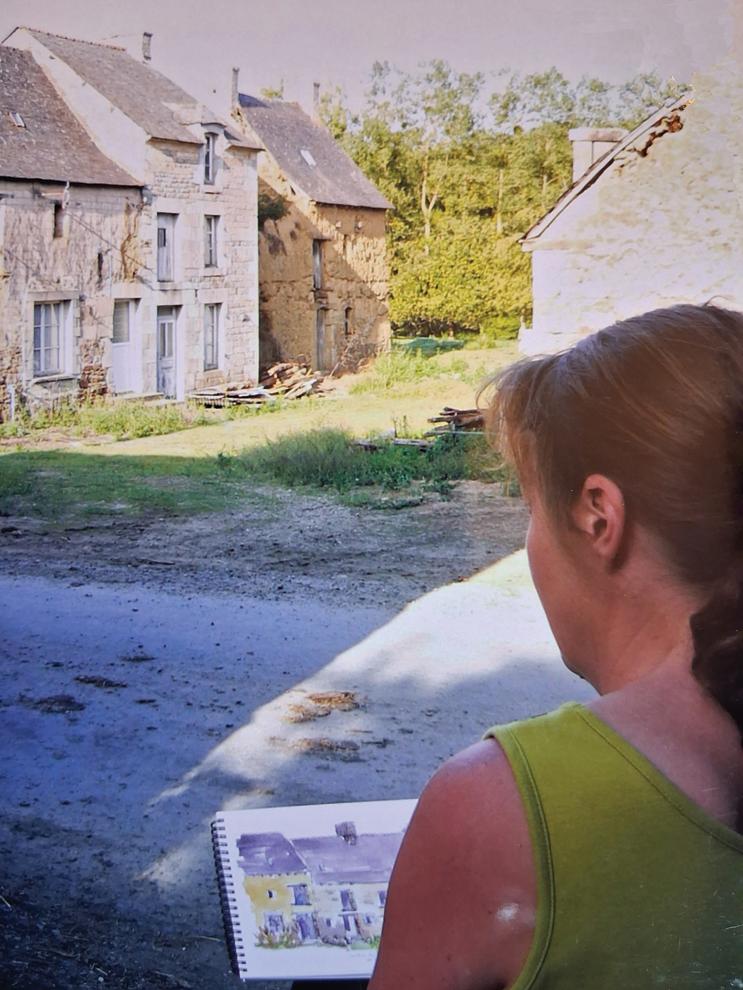

I first used a 10 inches x 7 inches Winsor & Newton watercolor spiral pad. Each painting was 10 x 7 inches Sometimes I would take a photo of the location or myself painting in the location and add it to the book.
On last year’s trip to France, I got a new sketchbook. This one is 8 inches x 5 inches made by Arteza. I started doing my paintings 8 x 5 inches. This sketchbook does not have a spiral, so when you open the book, you now can paint across both pages and do a painting 16 x 5 inches. I like the size format for painting street scenes. It’s more of a panorama wide angle view.
I also have a tiny Moleskin sketchbook that’s only 5 x 3 inches. This size is great when I go backpacking or when I only want to carry a very small kit.
I have a couple of different size watercolor palettes. Some you can add your own colors (favorite color for shadows is Daniel Smith’s Moonglow). I have a Derwent small palette that’s 5 ½ x 3 inches which comes with a brush that you can fill with water. This one is
good to use with my tiny sketchbook.
I use only a few brushes, such as a small angle brush, a flat brush that is about ½ inch and a small round brush for details. I use a mechanical pencil, kneadable eraser and an ink pen like Micron .05. I will have a couple of pieces of paper towel and a very small plastic container for water. It all goes in a large zip lock bag.
My process is to first do a pencil sketch, then do the watercolor, then the ink. Then I usually go back and add some shadows.

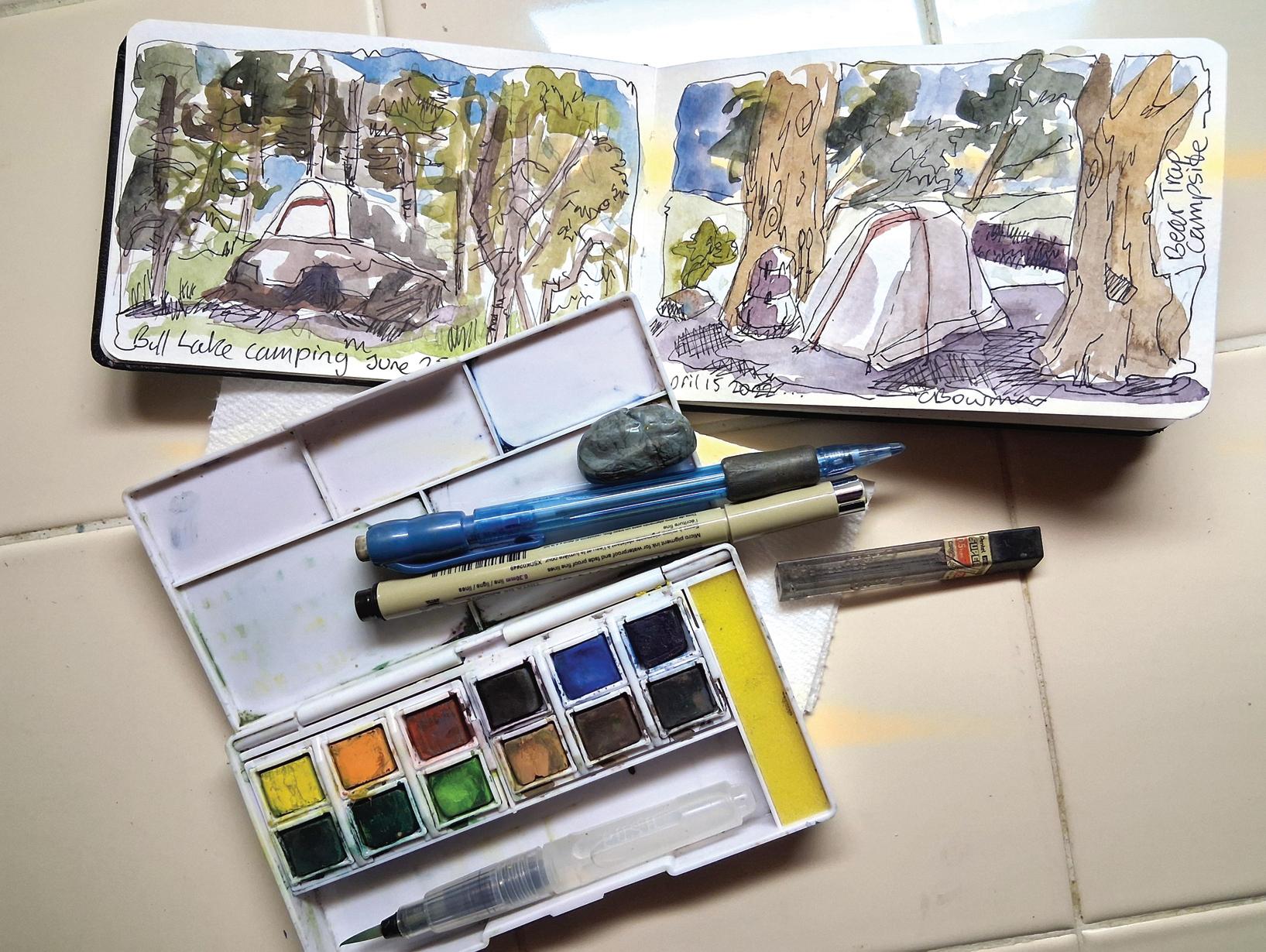


Sharon Lichtenstein is a Florida artist working primarily in soft pastels. She has exhibited locally and nationally. The native plants, trees and birds of the gulf coast are her primary inspiration.
I’ve found that a sketchbook is more than just a collection of drawings—it’s a constant companion and diary. Whether tucked in my bag or stashed in the car, it’s always within reach ready to capture the moments of my day.
When I began traveling more consistently, I initially relied on photographs to document my adventures, reviewing them at home to inspire sketches and paintings. However, it was the encouragement from several art groups, both locally, and online that truly ignited my passion for sketching on the go. Over the years, sketching has become a priority, a routine that enriches my travels and deepens my connection to the places I visit.




Sharon Lichtenstein in Portugal.
Sometimes a simple sketch is all it takes to transport me back to a particular location. Various workshops and challenges with artists, especially Marla Baggetta, have expanded my repertoire, encouraging me to include personal notes and experiences alongside my sketches. With a background in graphic design, I often find myself designing the page as I sketch, sometimes incorporating location, details, dates, or themes.
I started out with black and white sketches in little Moleskin sketchbooks, which are perfect for their portability and discretion—ideal for sketching in public places, like airports or high-speed trains. As my confidence grew, I ventured into mixed media and watercolor sketching. My supply kit remains simple: pencils, pens, a small watercolor set, various markers. Lately I’ve been enjoying Tombow gray scale markers and some gouache. My favorite sketchbooks are the Stillman and Birn Novo series for mixed media and the Pentalic watercolor sketchbook.
For anyone hesitant to start sketching while traveling, I say don’t be intimidated. Once you dive in it becomes a
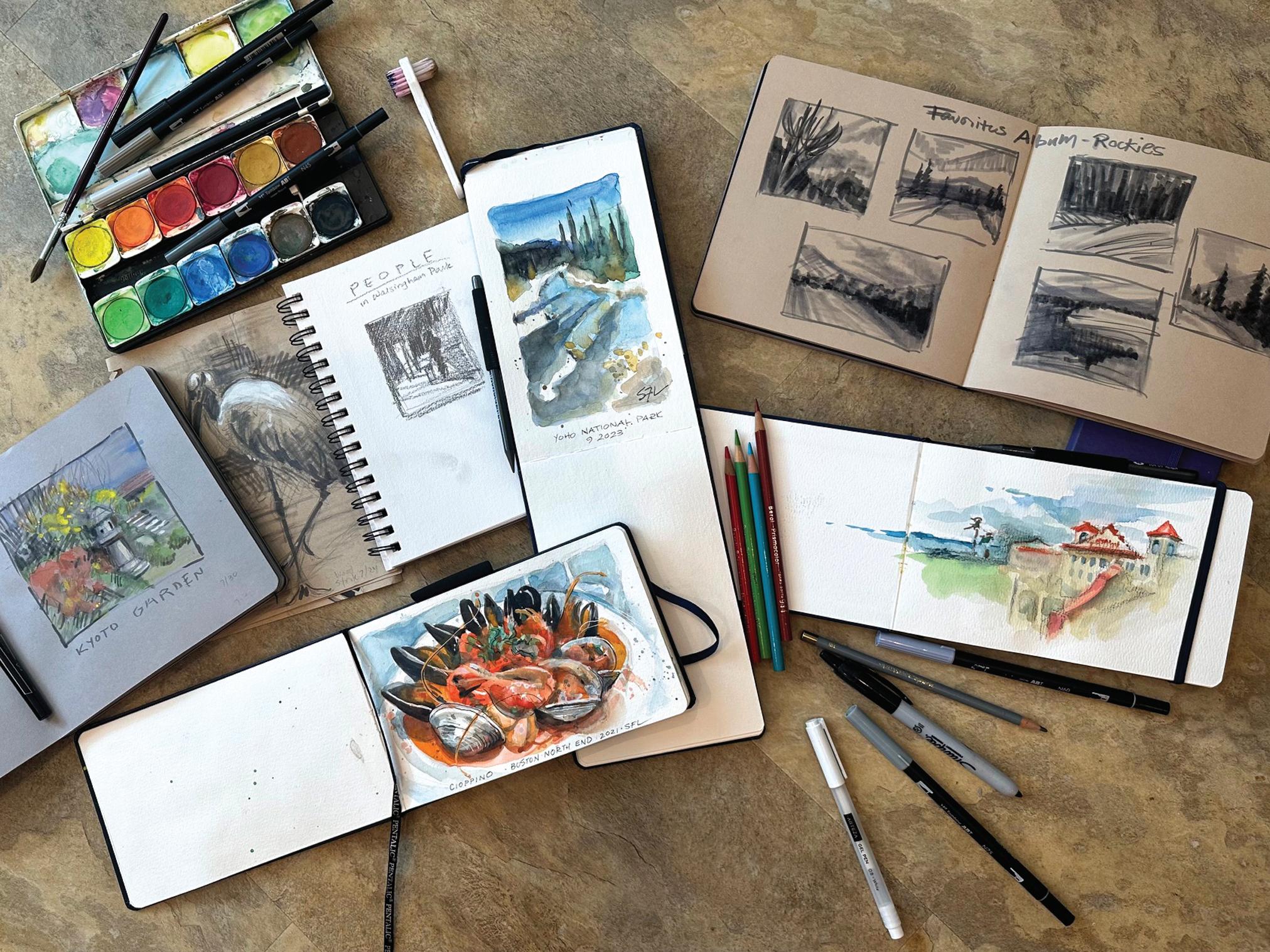

fun and rewarding part of your travel experience. Planning for sketching time is essential though, especially if you’re not traveling with fellow artists. My friends recently joked that I intentionally sprained my ankle in Barcelona, to skip a guided hiking tour and sketch instead.
Some of my favorite sketching destinations have been Kyoto, Japan, Banff, Canada, Croatia, particularly Split, and the Ben Lomond National Park near Queenstown, New Zealand.
Japan, which topped my bucket list for many years was a dream come true in 2023. Now I’m eager to explore more Asian locations and experiences. The landscapes are so beautifully different from my own.
While photos capture the scene, it’s through sketching that I truly feel I come to know a place. Each sketch becomes a memory that you’ve made your own!
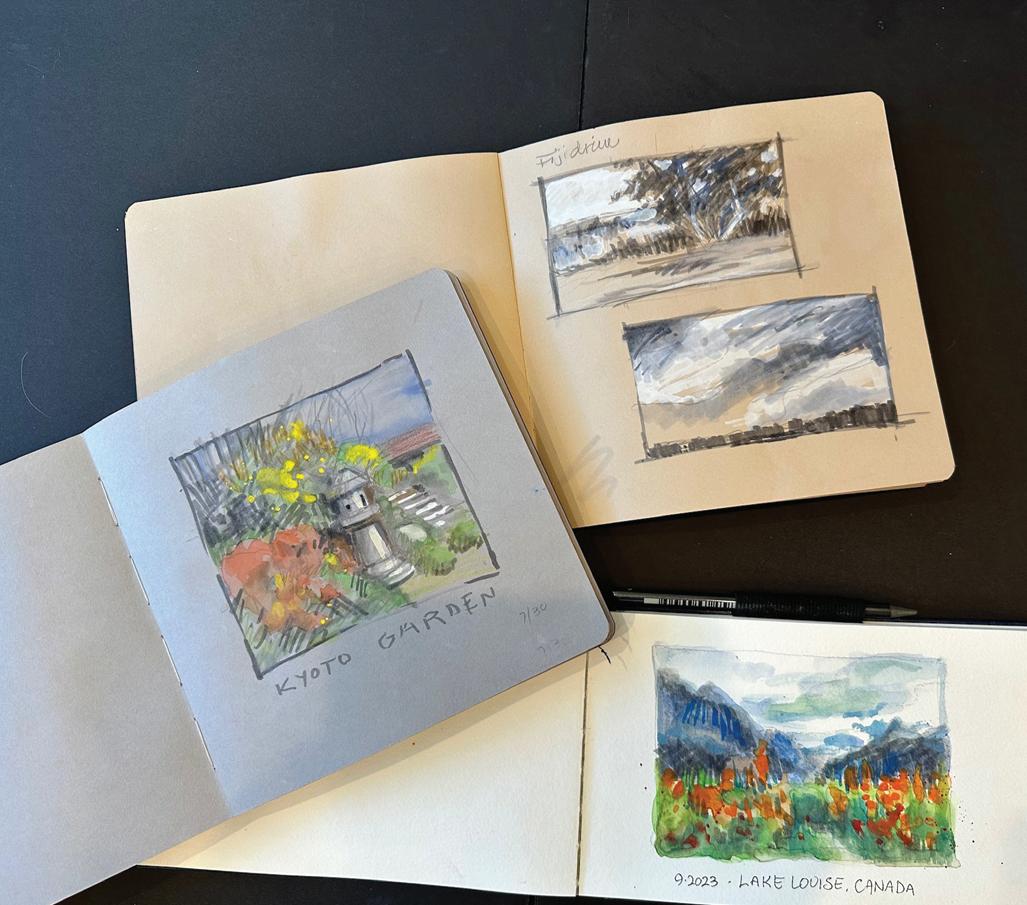






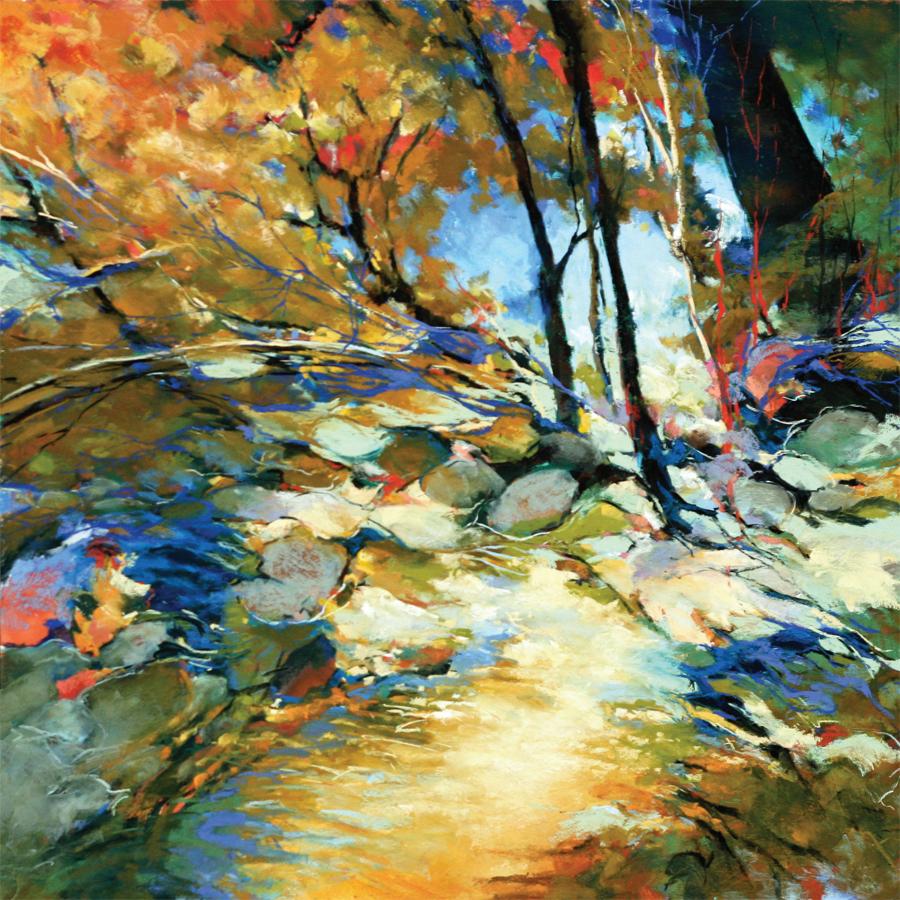
AUGUST 27 – 29, 2025 10:00 AM – 4:00 PM EACH DAY
In-person workshop through PSWC www.pswc.ws/workshops
$395 for 3-day workshop
Hilbert Museum of California Art Chapman University 167 N. Atchison Street Orange, CA 92866
Join Colette as she explores how intentional control of a painting’s composition sets the stage for the effectiveness of what you want your landscape to say and how you want it to feel. Beginning with a brief examination of the historical and cultural power of compositional conventions, follow along as Colette shares her best practices for moving her treatment of the landscape beyond mere representationalism. Gather ideas of how to work from your photos—even poor ones—to emphasize the abstract and emotional qualities inherent within realistic images. Emphasis is placed on working in a supportive environment to develop skills, practice techniques, and attend to your personal artistic development.
Each day will include direct instruction, and examples, with individual work time and feedback. Colette will demonstrate her process, offering insights into her decision-making and responses to the work in progress. One-on-one guidance and encouragement are provided during generous working time. A collaborative atmosphere provides plenty of growth opportunities.


Colette’s paintings have been featured in several books and art publications and exhibited widely in the United States, France, Germany, and China. They have received over 70 regional, national, and international awards. Ms. Smith has written articles and juried for the Pastel Journal and The Artists Magazine. She has judged the international exhibitions of the Pastel Society of America (PSA) and the International Association of Pastel Societies (IAPS). She has been honored as a Maître Pastelliste by the Societe des Pastellistes de France, Master Pastelist and Advisory Board Member by PSA, Eminent Pastelist and Masters’ Circle member by IAPS, and Distinguished Pastelist by the Pastel Society of New Mexico. Her work hangs in public, corporate and private collections, including the Ming Gallery Museum of Pastel in Suzhou, China. She offers her work in the spirit of service. www.coletteodyasmith.com
OCTOBER 10 – 12, 2025
9:00 AM – 4:00 PM EACH DAY
In-person workshop through PSWC Register online at pswc.ws/new-workshops/ $475 for 3-day workshop
Arts & Culture El Dorado’s
Switchboard Gallery 525 Main Street Placerville, CA 95667


Doug Dawson's art has been honored nationally and internationally. He received awards from Pastel Society of America, American Watercolor Society, Knickerbocker Artists, National Academy of Western Art, South Eastern Pastel Society, Pastel Society of West Coast, Pastel Society of New Mexico, Audubon Artists, Kansas Pastel Society, Pastel Society of the Southwest, and International Association of Pastel Societies. He was declared Master Pastelist by the Pastel Society of America. He is a member the Master Circle of the International Association of Pastel Societies, and he is in the Pastel Society of America's Hall of Fame. Doug has taught art for Colorado Institute of Art, Colorado Christian University, and The Art Students League of Denver, where he is a founding board member. Doug’s works range from expressive portraits to urban night scenes to emotive landscapes. All of them capturing the light and mood of the moment-in-time. His work has been in over 14 museums and over 40 books and magazines. His book, Capturing Light & Color with Pastel (1995) is an important reference for painters at all levels.
www.dougdawsonstudio.com

This workshop is open to pastel and oil artists. In the three days of the workshop, much material will be covered. After a painting demonstration by Doug, students will work on their own paintings.
The second and third days each begin with short illustrations of painting principles by Doug. Students will continue to work on their own paintings and Doug will provide individual help.
Topics covered during the workshop include:
• Black and white and color thumbnail sketches,
• Three types of designs that characterize compelling paintings,
• The principles that are used to create the illusion of depth in a landscape,
• The principle of the common color and the underlying concept of color harmony,
• How to solve color problems as you paint,
• Different approaches to underpainting,
• Other topics about which participants have questions.
At the end of each day there will be a critique of work done that day. Students are invited to bring in additional work for the critique if they wish.

In this three-day workshop students will learn how to infuse their paintings with energy and motion, be it fast, slow, loud, quiet. We will combine underpainting techniques, mark making and the process of additive and subtractive painting. An emphasis of experimentation through presented exercises will be used to push yourself to create more expressive works. To not be bound by what the reference looks like, but to paint what the reference makes you feel. The first two days will be a series of exercises working from provided photo references. The last day students will work from their own references to implement some of the techniques they have learned.
My approach is one that is filled with experimentation, and openness to create in an atmosphere without fear. I try hard to have students push out of their comfort zones to help them start to achieve the goals they have for themselves. I am focusing on the art fundamentals in a playful, yet serious manner. We will be starting each day with a warmup journal that I provide of mini exercises. This has been very well received at my workshops.
NOVEMBER 13 – 15, 2025 9:00 AM – 4:00 PM EACH DAY
In-person workshop through PSWC www.pswc.ws/workshops
$350 for 3-day workshop
Riviera United Methodist Church
375 Palos Verdes Blvd
Redondo Beach CA 90277


Anne Strutz graduated from Rhode Island School of Design and her career started in Fashion Design in New York City. While raising her family, she developed art curriculum and taught in Philadelphia and Chicago. After moving to North Carolina, Anne began building her fine art career working in pastels and became an awardwinning pastel artist, recognized as an "Artist to watch" by the Pastel Journal Magazine.
Anne is a signature member of the Pastel Society of America and holds Master Circle Status in the International Association of Pastel Societies. Anne has authored multiple articles for Pastel Journal, Artist Magazine and the Pastel Society of the West Coast Magazine. She has been featured in the French magazine Pratique de Arts. Anne began working with oil and multi-medium in 2023 to expand her artistic expression.
www.annestrutzfineart.com
JANUARY 9, 16, 23, 30, 2026
1:00 – 5:00 PM EACH SATURDAY
Online 4-week course through PSWC
Register online at pswc.ws/new-workshops/
$365 for Members
$390 for Non-Members
Class size is limited!


Laura Pollak is an award-winning, full time professional fine artist. She has attained Master Circle Status with the International Association of Pastel Societies as well as Signature Status of the Pastel Society of America, Pastel Society of the West Coast, Pastel Society of North Carolina, and Master Painter of the Southeastern Pastel Society. Laura is a newly juried in member of Women Artists of the West. Laura is often requested to do demos and teach workshops for pastel societies around the country. Her online teaching brings students from around the globe including Australia, Europe, New Zealand, Hawaii and Taiwan. She is a sought after mentor helping individual artists achieve their artistic goals.
laurapollak.com

Some of the topics covered in this series will be:
• Demonstrate how to construct and design a powerful and dramatic painting whether landscape or abstract.
• Conveying emotion and intent
• Design
• Turning to inspiration (it’s all around you!)
• Choosing and editing your reference photos
• Guided exercises for design, value, mark making, edges
• How to transform an idea to a painting
• Understanding the value of color
• Using apps to help you get past getting stuck (and make painting a whole lot easier)
• Special effects to make your art unique
• One-on-one instruction to help artists to the next level
• Art reviews with clear ideas to improve your art
This format takes the stress out of a workshop allowing you to absorb the concepts between classes. All sessions will be recorded and available for two months of viewing! A free, online bulleting board will allow us to share works, and a private Facebook community will allow for interaction between sessions.
NAME
Rose Ash Claremont CA
Joanne Clark Santa Cruz CA
Karen Conger Bakersville CA kelizc.art
Cristine Crooks Santa Barbara CA
Desiree Jane Currier Phoenix AZ DesireeJane.com
Sharon Ferguson Santa Cruz CA
Kathleen C. Gamper Davis CA instagram.com/kgamper/
David Knowles Encinitas CA
Patricia Larenas Mountain View CA plarenasonpaper.com/
Melissa Lovett-Adair San Luis Obispo CA
Debbie MacDonald Tijeras NM debbiemacdonaldart.com
Joy Morgan Corona CA
Desmond O’Hagan Denver CO desmondohagan.com
Stephen Petroschek Bellefontaine OH
Abigail Racco Lodi CA
Sue Scott Springfield OR
Kate Smit Santa Cruz CA katesmit.com
Christine Mavis Vance Missoula MT

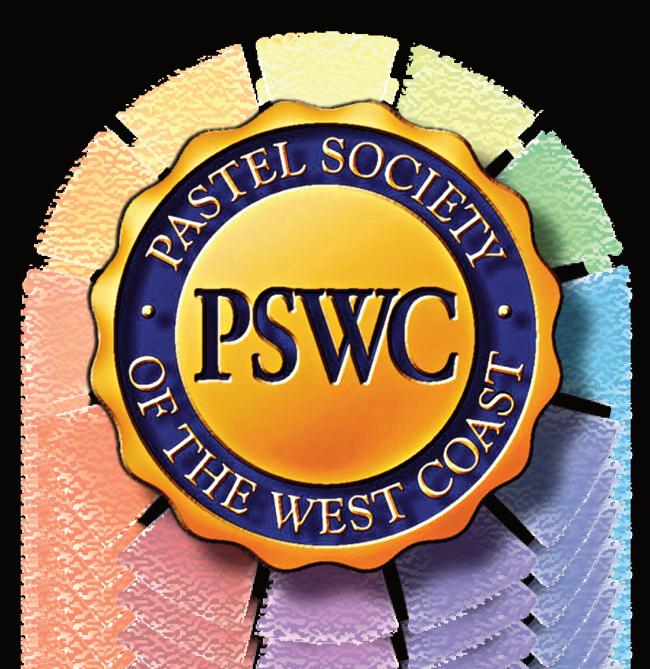
EXECUTIVE BOARD
PRESIDENT REGIONAL REPS OUT OF BOUNDS CO-CHAIR Pamela Comfort
VICE PRESIDENT PASTELS USA: 99 VOICES CHAIR Lynn Attig
SECRETARY WE TALK ART HOST OUT OF BOUNDS CO-CHAIR
Bonnie Zahn Griffith
TREASURER
501(c)3 COORDINATOR Deborah Pepin
AT-LARGE BOARD MEMBER Sabrina Hill
BOARD APPOINTEES
MEMBERSHIP COORDINATOR Open
MEMBERSHIP SHOW (MOOS) CHAIR SA Kushinka
WAYS & MEANS COORDINATOR Open
WORKSHOP COORDINATOR Jean Vineyard Myers


MAGAZINE EDITOR MARKETING Francesca Droll
WEBSITE MANAGER SOCIAL MEDIA COORDINATOR Delcee Comfort Fields
MEMBERSHIP STATUS Jan Miller
SCHOLARSHIP CHAIR Kim Essex

